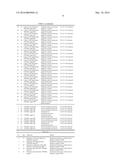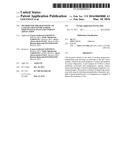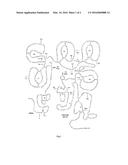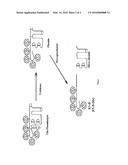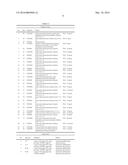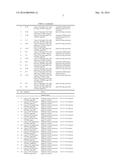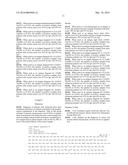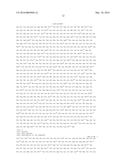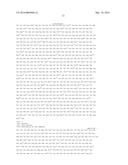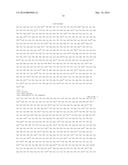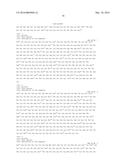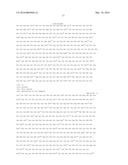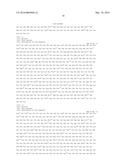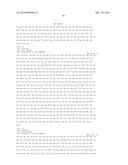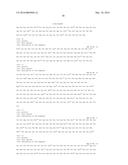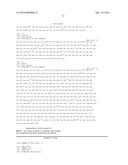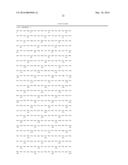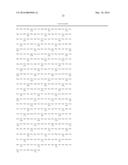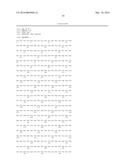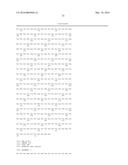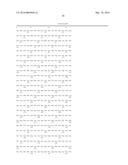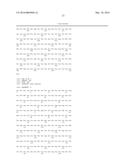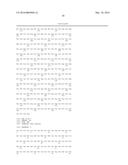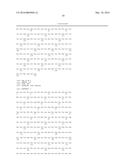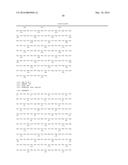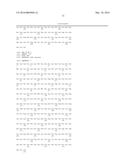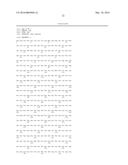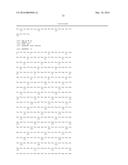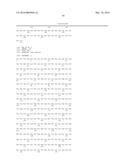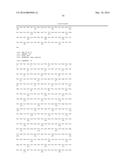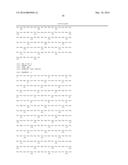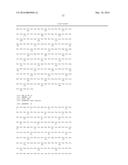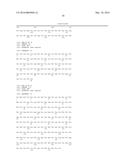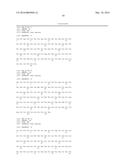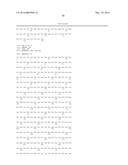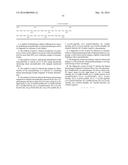Patent application title: METHOD FOR THE DIAGNOSTIC OF CANCER AND ENZYME-LINKED IMMUNOASSAY (ELISA) KIT FOR ITS APPLICATION
Inventors:
Evgeny Iosifovich Goufman (Moscow, RU)
Vasily Nikolaevich Yakovlev (Moscow, RU)
Alexei Alexeevich Kanaev (Moscow, RU)
Rustam Raisovich Suleimanov (Moscow, RU)
IPC8 Class: AG01N33574FI
USPC Class:
435 792
Class name: Involving antigen-antibody binding, specific binding protein assay or specific ligand-receptor binding assay assay in which an enzyme present is a label heterogeneous or solid phase assay system (e.g., elisa, etc.)
Publication date: 2016-03-10
Patent application number: 20160069888
Abstract:
The invention relates to the field of medical diagnostics, immunology and
oncology, in particular to the new tumor markers, useful in the early
diagnosis of cancer and methods for cancer diagnostics. A new antigen for
ELISA to detect antibodies associated with malignancies, namely, mature
human plasminogen or human plasminogen fragments containing kringles. We
propose a method of diagnosing cancer at an early stage by detecting
autoantibodies of type IgA, IgG, IgM to human plasminogen or its
fragments in a samples of human blood plasma or sera.Claims:
1. A method of identifying a subject suffering from cancer, by
identifying autoantibodies to human plasminogen and/or its fragments in a
plasma of said subject.
2. The method of claim 1, wherein an indicator of a presence of cancer in the subject is an excess of the autoantibodies level by more than 20% over a reference sample of autoantibodies.
3. The method of claim 1, wherein the identification of the autoantibodies is carried out by ELISA using specifically interacting these autoantibodies with antigens mentioned above.
4. The method of claim 3, wherein the antigen for identification of the autoantibodies is a full-size or containing human plasminogen kringle fragment of human plasminogen.
5. The method of claim 4, wherein the human plasminogen fragments to identify autoantibodies selected from a list: Lys-plasminogen, the heavy chain (Glu-H), heavy chain (Lys-H), light chain (L), K1-4 (Tyr80-Ala440), K1-3 (Tyr80-Val338), K1-3 (Tyr80-Val354), K1-4 (Asn60-Pro447), K1-4 (Lys78-Pro447), K1-4 (Lys78-Pro446), K1-4 (Lys78-Lys468), K1-4, 5 (Lys78-Arg530), C4-5 (Val355-Phe546), K1 (Tur80-Glu164), K2-3 (Cys165-Val338), K4 (Val354-Ala440), K5 (Ser441-Fhe546), K5 (Val442-Arg561), mini-plasmin.
6. A diagnostic ELISA system for detection of autoantibodies to human plasminogen and/or fragments thereof, comprising: a solid carrier and an antigen, capable of specifically binding to these autoantibodies.
7. The diagnostic system according to claim 6, wherein the antigen is a full molecule of human plasminogen or its fragment having at least one kringle.
8. The diagnostic system of claim 7, wherein the human plasminogen fragment is selected from a list: Glu-plasminogen, miniplasmin, Lys-plasminogen, the heavy chain (Glu-H), heavy chain (Lys-H), light chain (L), K1- 4 (Tyr80-Ala440), K1-3 (Tyr80-Val338), K1-3 (Tyr80-Val354), K1-4 (Asn60-Pro447), K1-4 (Lys78-Pro447), K1-4 (Lys78-Pro446), K1-4 (Lys78-Lys468), K1-4, 5 (Lys78-Arg530), C4-5 (Val355-Phe546), K1 (Tur80-Glu164), K2-3 (Cys165-Val338), K4 (Val354-Ala440), K5 (Ser441-Fhe546), K5 (Val442-Arg561).
Description:
CROSS-REFERENCE TO RELATED APPLICATIONS
[0001] This application is a national stage application of PCT/RU2012/001148 filed on Dec. 29, 2012 which claims priority to Russian application RU2012148244 filed on Nov. 14, 2012 currently issued as a patent RU2522231.
FIELD OF THE INVENTION
[0002] The present invention relates to the field of medical diagnostics, immunology and oncology, in particular to the discovering of new tumor markers. The invention is to the early diagnostics of cancer. More specifically, the present invention relates to one of the new universal tumor markers of neoplastic processes, namely, the autoantibodies against plasminogen or its fragments produced in the human body during the growth of tumor and its progression. The invention also relates to methods for diagnosing cancer by detecting these autoantibodies in a sample of human blood plasma. A Kit of enzyme immunoassay is proposed for detection of autoantibodies. The invention also relates to antigens, which are interacted with human autoantibodies that these antigens will use in the diagnostic of cancer.
Terminology
[0003] Technical and scientific terms used in the description, have the same meaning and value, which are commonly used in the relevant areas of science and technology.
[0004] The term "antigen" as used herein, refers to proteins or fragments thereof, capable of binding with antibodies.
[0005] The term "kringle" refers to a protein domain that has a structure stabilized by three disulfide bonds.
[0006] The term "domain" refers to a section of the protein, which is characterized by certain structural and functional properties.
[0007] The term "immunoassay" refers to methods of identifying high-molecular compounds, comprising the steps of: (a) the step of contacting the antigen with a biological sample under conditions suitable for the formation of antigen-antibody complexes, and (b) the stage of detection of these complexes.
[0008] The term "tumor marker" refers to a high-molecular compounds defined structure, revealing that in the samples of human tissue is associated with cancer.
[0009] The term "epitope" in the present invention refers to a section of the protein molecule that can form a bond with the antibody.
[0010] The term "human antibody" refers to an antibody having an amino acid sequence that corresponds to the amino acid sequence of the antibody produced by man.
[0011] The term "autoantibodies" (auto-aggressive antibodies, autologous antibodies)--antibodies capable to react with autoantigens, that is, with the body's own antigens.
BRIEF DESCRIPTION OF DRAWINGS
[0012] FIG. 1. The primary structure of Human plasminogen.
[0013] FIG. 2. Scheme of transformation of Glu-plasminogen to the heavy (K1-5+30 r) and light chain (micro-plasmin).
DESCRIPTION OF THE RELATED ART
[0014] The search of new tumor markers for the diagnosis of cancer in the early stages of the pathological process is one of important approach in the battle with cancer. The beginning of neoplastic processes may be due to various causes, so specific diagnosis requires to use many different markers with specificity to each type of tumor. Thus, the most useful in the early detection of cancer are the universal tumor markers, the detection of which is associated with a starting neoplastic process any kind.
[0015] According to the studies of Folkman, the balance of angiogenic and antiangiogenic systems should be stable for normal development of the organism. During normal processes such as organogenesis in the embryo and wound healing in the adult, angiogenesis provides the necessary vascular support for the newly developing tissue. It is known that tumor tissue contains much more blood vessels and capillaries than the surrounding healthy tissue. For these vessels to the fast-growing tumor cells enter the nutrients and oxygen that need to divide. The tumor growth and lethality are dependent upon angiogenesis and that angiogenesis inhibition suppresses tumor development (Folkman J. Angiogenesis in cancer, vascular, rheumatoid and other disease. Nat Med 1995; 1:27-31, Folkman J. Tumor angiogenesis. Adv Cancer Res 1985; 43:175-203).
[0016] It is known a minimal amount of cancer cells are appeared in the tissues, but organism is resistant of them, though some conditions would be suitable for their development (sufficient number of vessels, appropriate microenvironment, and their volume is greater than 2 mm 2) the tumor will begin to grow rapidly.
[0017] The role of serine proteases in oncogenesis and other systemic diseases is actively investigated. Secretion of serine proteases by tumor cells leads to the destruction of normal tissue architecture, invasion of these cells into the host tissue. These enzymes, both endogenous and exogenous, can remove from the cell surface specific proteins, which leads to the change in the adhesive properties of cells. Serine proteases secreted from tumor tissue interstitial fluid, can destroy the primary capillary membrane, facilitating the penetration of tumor cells through the vessel wall to the tissues of the host and the formation of metastases. Plasminogen/plasmin takes special attention in the class of serine proteases involved in process of oncogenesis whereas it has antiangiogenic properties too. Angiostatin and some other products of degradation of plasminogen are components of antiangiogenic plasminogen system.
[0018] Plasminogen is inactive precursor of plasmin. Plasmin is a endopeptidase with trypsin-like serine protease activity. Physiological action of plasmin is to control the balance of coagulation system. Plasmin is usually performed from the plasminogen by activation of streptokinase, urokinase in vitro. Native glu-plasminogen is readily converted to lys-plasminogen by plasmin hydrolysis of the Lys-77-Lys-78 bond. The system of plasminogen/plasmin is active not only in the process of fibrinolysis, but is closely associated with process of carcinogenesis. It was demonstrated a strong relationship between plasmin and metalloproteases, which are active components in carcinogenesis (Yves A. DeClerck and Walter E. Laug: Plasminogen: Structure, Activation, and Regulation, edited by David M. Waisman. Kluwer Academic/Plenum Publishers, New York, 2003). Apart from a native molecule of plasminogen (plasmin), a whole range of products of its degradation are functionally significant. Effect of degradated forms of plasmin to small molecule substrates may exceed of whole molecule (J G Klys, N V Zaitseva, A I Kizim, SV rope Proteolytic derivatives of plasminogen in the development of cancer, oncology, T 12, No 1, 2010).
[0019] In the process of degradation of the molecule plasminogen (plasmin), light and heavy chains can be obtained. The light chain contains the active site of plasmin, which is characteristic for the whole class of serine proteases. The heavy chain contains five kringles (triple disulfide-linked loops) regions. Each of these kringles or combination has its functional specialization. There are variants of the existence of the kringles in plasma: K1-3; K2-3; K1-4; K1-4,5; K1-5 and some single Kringles (Perri S, Martineau D, Francois M, et al. Plasminogen kringle 5 blocks tumor progression by antiangiogenic and proinflammatory pathways, Mol Cancer Ther 2007; 6:441-9). Well known that all Kringles, and combinations thereof are actively involved in angiogenesis and tumorigenesis. (Cao et al., J. Biol. Chem. 271:29461-29467, 1996; U.S. Pat. No. 6,024,688 to Folkman et al.) The functional activity of the first four kringle (K1-4) was widely investigated. The sequence of the kringles 1-4 is named angiostatin. (Francis J. Castellino, Victoria A. Ploplis, Structure and function of the plasminogen/plasmin system, Thromb Haemost 2005; 93:647-54; C. Boccaccio and Paolo M. Comoglio Cancer Res 2005; 65(19):8579-82; Rijken D C, Lijnen H R. New insights into the molecular mechanisms of the fibrinolytic system. J Thromb Haemost 2009; 7:4-13).
DETAILED DESCRIPTION OF THE INVENTION
[0020] Authors performed a preliminary study comparing blood samples of cancer patients and controls using two-dimensional electrophoresis followed by mass spectrometry procedure of interesting spots. Preliminarily, samples were prepared using lys-sepharose. It was found a concentrations of some proteins in cancer patients are significantly much higher than in the controls. 90% of these proteins after mass-spectrometric identification were identified as fragments of plasminogen with a molecular mass of less than 55 kDa and immunoglobulins.
[0021] The inventors have suggested that in in the area of tumor growth certain peptides are formed in high concentrations that may lead to the production of autoantibodies. These autoantibodies, in turn, can have an inhibitory effect on angiostatin and other derivatives of plasminogen and thus convert the balance in favor of angiogenic system. The neovessel organization is one of the conditions leading to the rapid growth of the tumor. Experiments performed by the inventors have shown the role of human autoantibodies in early detection of of the tumor growth. There are autoantibodies against their own plasminogen and various products of its degradation, particularly angiostatin. Increased titer of autoantibodies to plasminogen and or its degradation products in the plasma is a marker of tumor at an early stage and measurement of the level of autoantibodies to plasminogen and/or its degradation products in the plasma is diagnostic factor of developing cancer.
[0022] Tumors of internal organs do not have clear symptoms at early pathological growth usually. Malignant growth used to begin with chronic inflammation, without striking symptoms. Symptoms depend on the location and size of the cancer, as well as how amazed surrounding organs and tissues of the human body. Already formed a malignant tumor in stage I and II growth is painless and has no pronounced symptoms.
[0023] Nonspecific symptoms were taken in attention thorough examination of the patient, including through laboratory studies of blood plasma for early detection of cancer markers of the present invention.
[0024] Since autoantibodies are polyclonal and plasminogen molecule contains many epitopes, the inventors propose to use different parts of the plasminogen molecule to determine the titer of autoantibodies for early detection of cancer. Currently, there are no published sources data revealing the correlation between the appearance of autoantibodies in the blood plasma to plasminogen and/or its degradation products in cancer.
[0025] Plasminogen is a single-chain glycoprotein present in plasma at a concentration of about 2 mcM (Wahl et al., Thromb. Res. 27:523-535, 1982; Kang et al., Trends Cardiovasc. Med. 90:92-102, 1999). Plasminogen contains 791 amino acid residues and 24 disulfide bonds. Protein consists of a single polypeptide chain, where N-terminal amino acid is glutamine, C-terminal asparagine. The structure of the molecule has 2%-3% of carbohydrates, which are localized in the heavy chain. Oligosaccharides attached to Asp288 and Tre345. Plasminogen is a precursor of plasmin which is formed by cleavage of plasminogen between Arg-561 and Val-562 by tissue plasminogen activator or urokinase-type plasminogen activator. In the process of activation of plasminogen bond Arg560-Val561 is cleaved and two chains are formed, light and heavy, connected by disulfide bonds. The light chain (Val561-Asn790) has an active protease center, including the amino acid sequence of serine, histidine, asparagine. The heavy chain of plasmin (Lys78-Arg560) has five triple disulfide-linked loops known as kringle regions--or kringle domains, which is a compact globular structure with a hydrophobic core. These structures are involved in the process of protein interactions in blood clotting. Both plasminogen and plasmin bind to fibrin through amino-terminal kringle regions each of which is a triple loop region formed as a result of disulfide bonds. Kringles of heavy chain named K1, K2, K3, K4, K5. Kringles 1-4 have domains, specific areas, which have a strong affinity for lysine, ε-aminocaproic acid, parabens, and other ω-carbon amino acids having antifibrinolytic properties. Lysine binding sites (LBS) play an important role in the interaction between plasmin (plasminogen) to fibrin and plasmin to inhibitor--a2-AP (antiplasmin). Any fragment of human plasminogen containing any kringles can be used to detect autoantibodies associated with cancer, there is no matter whether a product of cleavage is from natural plasminogen or produced by splitting the plasminogen in vitro (eg, by enzymatic action).
[0026] Full-size human plasminogen and various products of its cleavage: light or heavy chain, and any of the fragments containing kringles, can be used as an antigens to produce a set of immunoassay for determination of autoantibodies classes IgG, IgA, and IgM in the samples of human plasma or sera. These antigens are derived from the native Glu-plasminogen, or can be obtained by using gene engineering techniques by recombinant peptide synthesis in eukaryotic and bacterial expression systems. Recombinant antigens are corresponding to amino acid sequence of human plasminogen. In particular, the antigen for the invention disclosed in the method of diagnosis, except for full-plasminogen. It may be the following fragments: Lys-plasminogen, the heavy chain (Glu-H), heavy chain (Lys-H), light chain (L), K1-4 (Tyr80-Ala440), K1-3 (Tyr80-Val338), K1-3 (Tyr80-Val354), K1-4 (Asn60-Pro447), K1-4 (Lys78-Pro447), K1-4 (Lys78- Pro446), K1-4 (Lys78-Lys468), K1-4, 5 (Lys78-Arg530), C4-5 (Val355-Phe546), K1 (Tur80-Glu164), K2-3 (Cys165-Val338), K4 (Val354-Ala440), K5 (Ser441-Fhe546), K5 (Val442-Arg561), miniplasminogen, and any combination thereof, (Table 1).
[0027] The inventors discovered and experimentally first confirmed that human plasminogen or its fragments can be used as antigens to determine the titer of autoantibodies in ELISA of human plasma and the result of this reaction can be used to diagnose the presence of cancer. So, as disclosed in the present invention, method of diagnosis is based on a well-defined polypeptides with unique amino acid sequences that any other proteins with identical primary structures and amino acid sequences are identical to those disclosed in the invention. It is clear that an antigens of the present invention can be any polypeptide having partial homology (90% and above) with the claimed polypeptides, since the replacement of individual amino acids does not alter the 3-dimentional structure of Kringle and not an obstacle to the interaction of the antigen-antibody.
[0028] Table 1 describes the various polypeptides--derived from human plasminogen. Kringle fragments form that can be used for preparation an enzyme immunoassay with samples of human blood plasma to detect autoantibodies associated with the growth of tumor.
TABLE-US-00001 peptide chain Mass, kDa Name Glu1-Asn791 98 Glu- SEQ ID NO: 1 plasminogen Lys78-Asn791 83, 5-84 Lys-plasminogen SEQ ID NO: 2 Glu1-Arg561 65 heavy chain (Glu- SEQ ID NO: 3 H) Lys78-Arg561 59 heavy chain (Lys- SEQ ID NO: 4 H) Val562-Asn791 25 (26, 3) light chain (L) SEQ ID NO: 5 Tyr80-Ala440 51-54 K1-4(Tyr80- SEQ ID NO: 6 Ala440) Tyr80-Val338 41 K1-3(Tyr80- SEQ ID NO: 7 Val338) Tyr80-Val354 44 K1-3(Tyr80- SEQ ID NO: 8 Val354) Asn60-Pro447 55 K1-4(Asn60- SEQ ID NO: 9 Pro447) Lys78-Pro447 58 K1-4(Lys78- SEQ ID NO: 10 Pro447) Lys78-Pro446 58 K1-4 (Lys78- SEQ ID NO: 11 Pro446) Lys78-Lys468 61 K1-4(Lys78- SEQ ID NO: 12 Lys468) Lys78-Arg530 66, 60, 57 K1-4,5 (Lys78- SEQ ID NO: 13 Arg530) Val355-Phe546 K4-5(Val355- SEQ ID NO: 14 Phe546) Tyr80-Glu164 9, 81 K1(Tyr80-Glu164) SEQ ID NO: 15 Glu1-Asn791 98 Glu- SEQ ID NO: 1 plasminogen Cys165-Val338 K2-3(Cys165- SEQ ID NO: 16 Val338) Val354-Ala440 10-12 K4(Val354-Ala440) SEQ ID NO: 17 Ser441-Fhe546 12 K5(Ser441-Fhe546) SEQ ID NO: 18 Val442-Arg561 K5(Val442-Arg561) SEQ ID NO: 19 Val442-Asn791 (40) 38 miniplasminogen SEQ ID NO: 20
[0029] FIG. 1 shows the primary structure of Human plasminogen.
[0030] Filled arrows identify the cleavage sites for: (a) the release of the signal peptide between residues--1 and 1, which is required for the generation of the mature form of the protein; (b) the release of the activation peptide (Glu'-Lys77) resulting in the conversion of Glu'-Pg to Lys78-Pg or Glu'-Pm to Lys78-Pm; (c) the activation of Human plasminogen to plasmin (CS) at the Arg561-Val562 peptide bond. Unfilled arrows identify introns in the gene sequence. Triangles locate the N-linked oligosaccharide site at sequence position 289 and the O-linked glycan at position 346. The catalytic triad, His603, Asp646, and Ser741, is also indicated (*). Disulfide bonds are depicted by heavy bars. .diamond-solid. phosphorylation site alanine--ala--A; arginine--arg--R; asparagine--asn--N; aspartic acid--asp--D; cysteine--cys--C; glutamine--gln--Q; glutamic acid--glu--E; glycine--gly--G; histidine--his--H; isoleucine--ile--I; leucine--leu--L; lysine--lys--K; methionine--met--M; phenylalanine--phe--F; proline--pro--P; serine--ser--S; threonine--thr--T; tryptophan--trp--W; tyrosine--tyr--Y; valine--val--V.
[0031] FIG. 2 shows the scheme of transformation of Glu-plasminogen to the heavy (K1-5+30 r) and light chain (micro-plasmin).
BRIEF SUMMARY OF THE INVENTION
[0032] Human plasminogen and its fragments disclosed herein (Table 1) were purified from blood plasma and used as antigens to create enzyme immunoassay for the determination of levels of autoantibodies class IgG, IgA, IgM to plasminogen/or its fragments in the blood of patients with various cancers, confirmed by alternative methods of diagnostics. According to the fact that the growth of all solid tumors is accompanied by increased growth of vessels and capillars in the area of the tumor the concentration of plasminogen and its products of degradation are used to increase in this area, that leads to the synthesis of autoantibodies to these products. Thus, the undoubted advantage of the present invention disclose the common marker of early diagnostic of cancer which is to the appearance of autoantibodies to plasminogen and its products of degradation in humans associated with the development of a tumor any kind.
[0033] Isolation of Antigens for ELISA.
[0034] The method for preparing of heavy chain (Glu-H) Glu1-Arg561 and light chain (L) Val562-Asn791 of human plasminogen.
[0035] The base of the method consists in the activation of plasminogen to plasmin, followed by reduction of S-S bonds between heavy and light chains in conditions that exclude autolysis, and using affinity chromatography on Lys-Sepharose 4B for the following separation. Urokinase cleave Arg561-Val562 bond in plasminogen. The resulting plasmin cut 77-78 bond and cleaved N-terminal peptide (1-77) is out. Mercaptoethanol reduct two bonds between Cys558-Cys566 and Cys548-Cys666, linking the heavy and light chains.
First Step:
[0036] Glu-Plasminogen was isolated from frozen donor human plasma by affinity chromatography on Lys-Sepharose 4B at 4° C., pH 8.0. Blood plasma was thawed in the presence of aprotinin, centrifuged 30 min at 4° C. and diluted 2-fold to 0.02 M phosphate buffer, pH 8.0, containing 20 KIU/ml aprotinin. Prepared plasma applied into a column with Lys-Sepharose 4B, equilibrated with 0.1 M K-phosphate buffer, pH 8.0, containing 20 KIU/ml aprotinin. The column was washed from unbound protein to 0.3 M phosphate buffer, pH 8.0, containing 20 KIU/ml aprotinin, overnight to absorbance at A280=0.05-0.01. Glu-Plasminogen was eluted with a solution of 0.2 M 6-aminocaproic acid, 0.1 M K-phosphate buffer, pH 8.0, containing 20 KIU/ml aprotinin. Fractions containing protein were pooled and subjected to further purification by precipitation (NH4) 2SO4 (0.31 g/ml protein solution). The precipitate was allowed to stand at 4° C. for 18-24 hours and then separated by centrifugation and dissolved in 0.05 M Tris-HCl buffer, pH 8.0 to a concentration of about 1.5-2.0 mg/ml. Purified Glu-Plasminogen dialyzed at 4° C. against water (pH 8.0) and lyophilized.
Second Step:
[0037] To a solution of Glu-plasminogen (5 mg/ml) in 0.05 M Tris-HCl buffer, pH 8 8, containing 0.02 M L-lysine, 0.15 M NaCl, 20% glycerol, and 6000 KIU/ml aprotinin urokinase was added to a final concentration of 600 IU/ml and incubated for 4 h at 37° C. The complete of conversion of Glu-plasminogen to plasmin was monitored by an increase to a maximum rate of hydrolysis of plasmin specific substrate S-2251 (HD-Val-Leu-Lys p-nitroanilide, "Sigma", USA) in samples taken from the reaction mixture.
Third stage
[0038] The reduction of S-S-bonds between heavy and light chains of plasmin.
[0039] Mercaptoethanol was added to the solution of plasmin to a final concentration of 0.25 mM and incubated under nitrogen in the dark for 20 minutes at room temperature. In the result, free SH-groups were blocked by adding freshly prepared solution iodoacetic acid in 0.1 M Na-phosphate buffer, pH 8.0 (final concentration of 0.315 M) and incubated for 20 min.
[0040] Fourth Stage:
[0041] The separation of heavy and light chains of plasmin by column chromatography on Lys-Sepharose 4B.
[0042] The reaction mixture was diluted to a concentration of 1 mg/ml of protein by 0.1 M Na-phosphate buffer, pH 8.0, containing 20 KIU/ml aprotinin and applied to Lys-Sepharose 4B column equilibrated with the same buffer. Chromatography was performed at 25° C. The heavy chain of plasmin has kringles 1-5 and 30 amino acid residues of the connecting peptide. It was adsorbed on the sorbent, but light chain is eluted with equilibration buffer. Heavy chain (MR˜56-57 kDa) was eluted by 0.2 M solution of 6-aminocaproic acid in 0.1 M Na-phosphate buffer, pH 8.0. The pooled fractions were dialyzed against water (pH˜8.0) and lyophilized.
[0043] The purity and molecular weight of the protein was investigated by 12% SDS-polyacrylamide gel electrophoresis.
[0044] Furthermore, the absence of amidase activity (for S-2251) before and after incubation with streptokinase its solution indicated that the heavy chain does not contain trace concentrations of miniplasminogen, which may not show up during electrophoresis.
[0045] The purification of Lys-plasminogen (Lys78-Asn791) and heavy chain (Lys-H Lys78-Arg561) was performed by the same method, but without inhibitor -aprotinin.
[0046] Isolation of miniplasminogen (Val442-Asn791). Miniplasminogen consist of K5 and light chain. Its sequence starts from Val442 to Asn791. Miniplasminogen obtained by incubation of Lys-plasminogen (Lys78-Asn791) with elastase followed by gel filtration on G-75 Sephadex.
[0047] Isolation of Kringle K1-4, 5 (Lys78-Arg530) was performed according to the method described in Cao R., Wu H. L., Veitonmaki N., Linden P., Farnedo J., Shi C.Y., and Cao Y, (1999) Proc. Natl. Acad. Sci. USA, 96, 5728-5733, with some modifications.
[0048] Glu-plasminogen (10 mg/ml) was activated with urokinase (600 ME/ml) in 0.05 M phosphate buffer, pH 9.0, containing 0.02 M L-lysine and 0.1 M NaCl, at 37° C. Complete conversion of plasminogen to plasmin was monitored by the increase in the amidase activity of the solution to the maximum value. An equal volume of 0.2 M glycerol buffer, pH 12.0 was added to a solution of plasmin and incubated for 18 h at 25 C, pH of 10.5. The reaction mixture was diluted 5-fold with buffer containing 0.1 M phosphate buffer, pH 8.0, and 40 KIU/ml aprotinin, and applied to a column of Lys-Sepharose 4B equilibrated with the same buffer. After the following out of microplasminogen, adsorbed K1-4,5 was eluted from the column with 0.2 M solution of 6-aminocaproic acid in 0.1 M phosphate buffer, pH 8.0 and 40 KIU/ml aprotinin, dialyzed against water and lyophilized. The purity of the substance was checked by 12% SDS-polyacrylamide gel electrophoresis.
[0049] Isolation of kringle K1-4 (Tyr80-Ala440) and K1-3 (Tyr80-Val338) K4-5 (Val355-Phe546) was performed using elastase treatment of Glu-plasminogen by the method described in the works of Cao Y., Ji R. W., Davidson D., Schaller J., Marti D., Sohndel S., McCanse S. G., O'Reilly M. S., Llinas M., and Folkman J. (1996) J. Biol. Chem., 271, 29461-29467. Glu-plasminogen was incubated with elastase at a ratio of 50:1 (M/M) in a buffer containing 0.05 M Tris-HCl, pH 8.5, 0.5 M NaCl, and 200 KIU aprotinin, for 5 hours at room temperature. The reaction was stopped by adding PMFS to maintain its concentration 1 mM for 40-50 min. Then gel-filtration on a column of Sephadex G-75 was performed to separate low and high molecular proteins. Protein fractions of the second peak containing K1-3, K1-4, K4-5 and miniplasminogen was applied to an affinity column with Lys-Sepharose 4B equilibrated with buffer containing 0.05 M Tris-HCl, pH 8.5, 0.15 M NaCl. After the flowing throw miniplasminogen which is not adsorbed on the Lys-Sepharose 4B, adsorbed fragments K1-3, K1-4 and K4-5 was eluted with a solution of 0.2 M 6-aminocaproic acid in the same buffer, dialyzed against a buffer containing 0.02 M Tris-HCl, pH 8.0, and applied to a column of heparin-agarose equilibrated with the same buffer. After elution of unbound fragment K1-4 and K4-5 with the buffer, the fragment K1-3 was eluted with a solution of 0.25 M KCl in the same buffer. The purified fragment K1 -3 was dialyzed against water and lyophilized. K1-4 and K4-5 were separated by gel filtration on Sephadex G-75.
[0050] Kringles K5 (Ser449 (Pro452)-Fhe546), K1-3 (Tyr80-Val338), K-4 (Val335-Ala440) were prepared according to the work of Cao, Y., Chen, A., An, S. S. A., Ji, R. W., Davidson, D., and Llinas, M. (1997) J. Biol. Chem. 272, 22924-22928). The method is to digest by elastase Lys-plasminogen (Lys78-Asn791). After processing elastase mixture was applied to a column of Mono-S (Bio-Rad) equilibrated with buffer containing 20 mM NaOAc, pH 5.0. Fragments of plasminogen were eluted by gradient 1 M KCl in buffer containing 20 mM NaOAc, pH 5.0. We used a gradient of 0-20%, 20-50%, 50-70% and 70-100%. K-5 release to 50%. For this scheme, but in a another gradient K-4 (Val335-Ala440) and kringle K1-3 (Tyr80-Val354) were obtained.
[0051] The method of isolation of K5 (Val442-Arg561) is to digesting by elastase of miniplazminogen (Val442-Asn791) containing 5-kringle of heavy chain following by digesting of the fragment by pepsin and then using the gel filtration and ion exchange chromatography according to the work (Theresa Thewes, Vasudevan Ramesh, Elcna L. Simplaceanu and Miguel Llinfis, Isolation, purification and I H-NMR characterization of a kringle 5 domain fragment from human plasminogen (Biochimica et Biophysica Acta 912 (1987), 254-269).
[0052] Kringle K1-4 (Lys78-Pro446) and K1-4 (Lys78-Lys468) was prepared according to the method with metalloproteinases (Patterson, B. C. and Sang, Q. A. (1997) J. Biol. Chem. 272, 28823-28825).
[0053] Kringle K1-4 (Asn60-Pro447) obtained by the method with metalloproteinases (Lijnen, H. R., Ugwu, F., Bini, A., and Collen, D. (1998) Biochemistry 37, 4699-4702).
[0054] Kringle K1 (Tur80-Glu164) and K2-3 (Cys165-Val338) were isolated from the K1-3 (Tyr80-Val338) by treating of pepsin (or protease s.aureus V8) with a further separation on lys-Sepharose and gel filtration on Sephadex G-75.
Preparation of Diagnostic Test Kits for ELISA of Autoantibodies
[0055] Glu-plasminogen or its fragments having at least one kringle were used as Antigens for ELISA of autoantibodies. Different types of antigens used in ELISA are listed in Table 1. Their primary amino acid sequence shown in the sequence listing.
[0056] The antigen was diluted in 0.1 M carbonate-bicarbonate buffer pH 9.6 in the maximum concentration of 5 μg/ml for molecules with a molecular weight of more than 25 kDa and 10 μg/ml for molecules with a molecular weight less than 25 kDa. These dilutions of antigen were used to identify all types of immunoglobulins.
[0057] PBS (phosphate buffered saline, phosphate salt solution):
[0058] 0.14 M NaCl; 0.003 M KCl, 0.005 M Na2HPO4, 0.002 M KH2PO4
[0059] Preparation 1 L 10× PBS:
[0060] 80 g-NaCl 2 g-KCl 18 g-Na2HPO4 2 g-KH2PO4
[0061] Substrate buffer solution (pH 4.3): 31 mM citric acid, 0.05 N NaOH, 3 mM H2O2
[0062] TMB solution: 5 mM 3,3', 5,5'-tetramethylbenzidine in 70% DMSO
[0063] Chrornogenic substrate solution (prepared before use): Mixed 4 parts of the substrate buffer solution and one part of the TMB solution.
[0064] To prepare a kit for ELISA was performed pre-immobilized antigen. To immobilize the antigen can be used different types of material such as nitrocellulose, glass beads or other particles that can absorb proteins, immunological plastic strips or plates. We used for experiments immunological plastic strips (Nunc). To each well was diluted into 100 μL antigen solution. Incubation was carried out for 14-16 hours at 37° C. in a humidified chamber. The antigen solution was removed by shaking out, and then wells washed twice by a solution containing a PBS with 0.05% Tweeen-20, 200 μL/well to remove unbound antigen. For the block was used solution of 1% gelatin in PBS, 200 μL/well, with incubation for 1.5-2 hours at room temperature. After incubation, the blocking fluid was removed, the plate was dried overnight at room temperature on air.
[0065] Control probes and tested samples were diluted in 50-fold by diluent (0.5% gelatin, 0.001 M EDTA in PBS), then were poured 100 μL into appropriate wells and incubated for 1 h at 37° C. After incubation, the solution were removed, the plate was washed four times with washing buffer (PBS with 0.05% Tween-20), each time carefully removing the contents of the wells. Working dilution of conjugate (to determine IgG, IgA, IgM as conjugate used respectively Mab Fc IgG-peroxidase, Mab Fc IgA-peroxidase, Mab IgM-peroxidase) were added into the appropriate wells of 100 mcl/well and then incubated for 1 h at 37° C. Unbound components were removed 4 times by washing of wash solution. Then in all the wells were added 100 μL of substrate-chromogen solution, and incubated for 15 minutes at 370 C. The reaction was stopped by adding to wells 100 μL of stop solution (2M H2SO4). Photometry was performed on vertical scanning photometer "UNIPLAN" (company "Picon", Russia) with a wavelength of 450 nm.
The Diagnostic of Cancer by Enzyme Immunoassay Detection of Autoantibodies to Human Plasminogen and/or its Fragments
[0066] Blood samples were taken from patients cubital vein using vacutaners with EDTA. The samples were then centrifuged at 3000 r/min for 15 min. Plasma was poured into tubes in 100 μL., Frozen and stored at -40 C.
[0067] The control group has plasma samples taken from 30 healthy men and 30 healthy women. Each sample was negative in tests for hepatitis A, B and C virus, HIV, tuberculosis and syphilis.
[0068] The level of autoantibodies IgG and IgA in the control samples was measured using the ELISA kit, according to the described method. Dilution of control plasma samples was chosen so that the optical density was less than 0.2.
[0069] The dilution of samples in ELISA was established of 1/50 for each tested samples, which was subsequently used for the analysis of all samples. The antigen was used as a whole molecule of glu-plasminogen, as its fragments. For accuracy, the determination of each sample was tested in duplicate. After measuring 30 male and 30 female control samples was calculated the average optical density for each of the control group used for testing with various fragments of plasminogen or full plasminogen molecule as a ligand.
[0070] ELISA test samples was performed with each individual antigen. Number of samples above the average in the male control group was within 2% to 5%, while in the women's within 3% to 6% when tested with all antigens investigated. For a comparative study of the control group to samples of cancer and other diseases for the control group were taken 5 samples with indicators of optical density, not more than 5% of the average. These five samples were mixed into one pooled sample--control sample (K), used as a reference level of autoantibodies to plasminogen or its fragments. The samples of control were different to the study of antibodies IgG, IgA and IgM.
[0071] To assess the effectiveness of various fragments of plasminogen for the early diagnostic of cancer was used the samples of plasma of patients with various forms of cancer (Table 2).
TABLE-US-00002 TABLE 2 Prostate Cancer No Age Diagnosis Biopsy 1 68 T2cNoMo small acinar adenocarcinoma amid mixed PSA - 35 ng/ml hyperplasia and chronic prostatitis. Gleason score 2 (1 + 1) 2 58 T2cNxMo acinar adenocarcinoma. Gleason score 6 (4 + PSA -9 ng/ml 2) 3 69 T3NxMo adenocarcinoma 4 67 T2aNoMo Focuses of small acinar adenocarcinoma, PSA 7 ng/ml Gleason score 4 points (2 + 2), mixed hyperplasia, chronic prostatitis 5 64 T2NxMo small acinar adenocarcinoma, Gleason PSA - 26 ng/ml score 5 (3 + 2) 6 63 T2cNoMo small acinar adenocarcinoma, Gleason CA-12 ng/ml score 7 (3 + 4) 7 62 ToNoMo small acinar adenocarcinoma, Gleason PSA - 35 ng/ml score 3 (1 + 2) 8 78 T2NxMo small acinar adenocarcinoma, Gleason PSA - 25 ng/ml score 5 (3 + 2) 9 72 T2NxMo small acinar adenocarcinoma, Gleason PSA - 50 ng/ml score 5 (3 + 2) 10 62 T2cNoMo small acinar adenocarcinorna, Gleason CA-10 ng/ml score 5 (2 + 3) 11 78 T3NxMx adenocarcinoma PSA - 20 ng/ml 12 73 T2NxMo small acinar adenocarcinoma, Gleason PSA - 55 ng/ml score 7 (4 + 3) 13 75 T2aN0Mo small acinar adenocarcinoma, Gleason PSA - 11 ng/ml score 4 points (2 + 2) 14 73 T3aNxMx small acinar adenocarcinoma, with PSA - 44 ng/ml hyperplasia and chronic prostatitis 15 60 T2N0M0 small acinar adenocarcinoma, Gleason PSA - 67 ng/ml score 7 (4 + 3) 16 66 T2NxMx Large acinar adenocarcinoma, Gleason PSA - 57 ng/ml score 5 (3 + 2) 17 71 T2bN0M1 acinar adenocarcinoma, Gleason score 7 (3 + PSA - 70 ng/ml 4) 18 70 T3N1M0 small acinar adenocarcinoma, Gleason PSA - 120 ng/ml score 9 (4 + 5) 19 73 T3N1M0 small acinar adenocarcinoma, Gleason PSA - 30 ng/ml score 3 (3 + 3) 20 78 T3N1M0 acinar adenocarcinoma, Gleason score 7 (3 + PSA - 70 ng/ml 4) 21 81 T2N0M0 acinar adenocarcinoma, Gleason score 7 (3 + PSA - 15 ng/ml 4) 22 78 T2N0M0 small acinar adenocarcinoma, Gleason PSA - 70 ng/ml score 7 (4 + 3) 23 46 T2N0M0 small acinar adenocarcinoma, Gleason PSA - 35 ng/ml score 6 (3 + 3) 24 71 T2cN0M0 Adenocarcinoma Gleason score 5 (2 + 3) PSA - 18 ng/ml 25 59 T3NxM1 Adenocarcinoma, Gleason score 8 (4 + 4) PSA - 225 ng/ml 26 64 T2N0M0 small acinar adenocarcinoma, Gleason PSA - 16 ng/ml score 5 (3 + 2) 27 73 T3aNxMx small acinar adenocarcinoma, with PSA - 44 ng/ml hyperplasia and chronic prostatitis, Gleason score 5 (3 + 2) 28 65 T3NxM1 small acinar adenocarcinoma, Gleason PSA - 163 ng/ml score 9 (4 + 5) 29 62 T2aNoMo Focuses small acinar adenocarcinoma PSA - 70 ng/ml 30 64 T2aNxMx Focuses small acinar adenocarcinoma, PSA - 14 ng/ml hyperplasia and chronic prostatitis Lung Cancer No Age, sex Diagnosis Biopsy 1 77 f Cancer of the upper lobe of the moderately differentiated left lung, T2N0M0, stage IB adenocarcinoma 2 71 f Cancer of the upper lobe of the moderately differentiated left lung, T2N0M0, stage IIB squamous cell carcinoma 3 80 M Cancer of the upper lobe of the moderately differentiated left lung, T2N1M0, stage IIB squamous cell carcinoma 4 65 M Cancer of the right upper lobe, moderately differentiated T2N0M0, stage IB squamous cell carcinoma 5 63 M Cancer of the upper lobe of the moderately differentiated left lung, T2N1M0, stage IIB glandular squamous cell carcinoma 6 70 M Cancer of the lower lobe of the small-cell lung carcinoma right lung, T2N0M0, stage IB 7 71 M Cancer of the right upper lobe moderately differentiated T2N0M0, stage IB glandular squamous cell carcinoma 8 71 f Cancer of the upper lobe of the small-cell lung carcinoma left lung, T4N2M0, stage IIIB 9 66 M Cancer of the lower lobe of the small-cell lung carcinoma right lung, T2N1M1, stage IV, with liver metastases 10 52 M Cancer of the right upper lobe small-cell lung carcinoma T2N2M0, stage IIIA 11 58 f Cancer of the lower lobe of the moderately differentiated right lung, T1N0M0, stage IA squamous cell carcinoma 12 57 f Cancer of the right upper lobe small-cell lung carcinoma T2N0M0, stage IB 13 55 M Cancer of the lower lobe of the small-cell lung carcinoma right lung, T2N0M0, stage IB 14 68 f Cancer of the upper lobe of the moderately differentiated left lung, T4N2M0, stage IIIB squamous cell carcinoma 15 65 f Cancer of the right upper lobe, Moderately differentiated T2N0M0, stage IB squamous cell carcinoma 16 65 M Cancer of the lower lobe of the small-cell lung carcinoma right lung, T2N0M0, stage IB 17 47 f Cancer of the lower lobe of the moderately differentiated right lung, T2N0M0, stage IA adenocarcinoma 18 31 M Cancer of the lower lobe of the small-cell lung carcinoma right lung, T2N1M1, stage Cancer of the upper lobe of the left lung, T4N2M0, stage IVB with metastases 19 54 f Cancer of the upper lobe of the small-cell lung carcinoma left lung, T4N2M0, stage IIIB 20 54 f Cancer of the right upper lobe small-cell lung carcinoma T2N2M0, stage IIIA No Age Diagnosis Biopsy Breast Cancer 1 63 Cancer of the right breast, Infiltrative ductal carcinoma, CA 15-3 120 units/mL T2N0M0, stage IIB grade II (6 points) 2 47 Cancer of the left breast, Infiltrative ductal carcinoma, CA 15-3 160 units/mL T2N1M0, stage IIA grade II (6 points)) 3 52 Cancer of the right breast, Infiltrative ductal carcinoma, CA 15-3 140 units/mL T2N0M0, stage IIB grade II (6 points) 4 65 Cancer of the left breast, Infiltrative ductal carcinoma, CA 15-3 110 units/mL T4N1M0, stage IIIB grade II (6 points) 5 59 Cancer of the left breast, Infiltrative ductal carcinoma, CA 15-3 140 units/mL T2N1M0, stage IIB grade II (6 points) 6 72 Cancer of the left breast, Infiltrative ductal carcinoma, CA 15-3 160 units/mL T2N2M0, stage IIIA grade III (8 points) 7 54 Cancer of the left breast, Infiltrative ductal carcinoma, CA 15-3 90 units/mL T1N0M0, stage I grade I (5 points) 8 73 Cancer of the right breast, Infiltrative ductal carcinoma, CA 15-3 100 units/mL T2N0M0, stage IIB grade II (7 points) 9 48 Cancer of the right breast, Infiltrative ductal carcinoma, CA 15-3 170 units/mL T4N0M0, stage IIIB grade II (7 points) 10 42 Cancer of the left breast, Infiltrative ductal carcinoma, CA 15-3 60 units/mL T4N1M0, stage IIIB grade II (7 points) 11 61 Cancer of the right breast, Infiltrative ductal carcinoma, CA 15-3 130 units/mL T2N0M0, stage IIB grade II (6 points) 12 46 Cancer of the left breast, Infiltrative ductal carcinoma, CA 15-3 150 units/mL T3N1M0, stage IIIA grade II (7 points) 13 47 Cancer of the left breast, Infiltrative ductal carcinoma, CA 15-3 100 units/mL T2N0M0, stage IIA grade I (5 points) 14 60 Cancer of the right breast, Infiltrative ductal carcinoma, CA 15-3 180 units/mL T2N0M0, IIB grade II (7 points) 15 62 Cancer of the right breast, Infiltrative ductal carcinoma, CA 15-3 90 units/mL T2N0M0, stage IIB grade II (6 points) 16 47 Cancer of the left breast, Infiltrative ductal carcinoma, CA 15-3 140 units/mL T4N1M0, stage IIIB grade II (6 points) 17 28 Cancer of the left breast, Infiltrative ductal carcinoma, CA 15-3 100 units/mL T4N1M0, stage IIIB grade II (6 points) 18 61 Cancer of the left breast, Infiltrative ductal carcinoma, CA 15-3 100 units/mL T4N1M0, stage IIIB grade II (7 points) 19 69 Cancer of the right breast, Infiltrative ductal Carcinoma, CA 15-3 110 units/mL T4N1M0, stage IIIB grade III (8 points) 20 50 Cancer of the left breast, Infiltrative ductal carcinoma, CA 15-3 110 units/mL T2N1M0, stage IIB grade II (6 points) 21 48 Cancer of the right breast, Infiltrative ductal carcinoma, CA 15-3 90 units/mL T2N1M0, stage IIB grade II (7 points) 22 80 Cancer of the left breast, Infiltrative ductal carcinoma, CA 15-3 70 units/mL T1N1M0, stage IIA grade II (6 points) 23 60 Cancer of the left breast, Infiltrative ductal carcinoma, CA 15-3 140 units/mL T2N1M0, stage IIB grade II (7 points) 24 62 Cancer of the right breast, Infiltrative ductal carcinoma, CA 15-3 100 units/mL T2N1M0, stage IIB grade II (6 points) 25 54 Cancer of the right breast, Infiltrative ductal carcinoma, CA 15-3 90 units/mL T4N1M0, stage IIIB grade II (7 points) 26 75 Cancer of the left breast, Infiltrative ductal carcinoma, CA 15-3 120 units/mL T2N2M0, stage IIIA grade III (8 points) 27 67 Cancer of the right breast, Infiltrative ductal carcinoma, CA 15-3 150 units/mL T4N1M0, stage IIIB grade II (7 points) 28 67 Cancer of the left breast, Infiltrative ductal carcinoma, CA 15-3 110 units/mL T2N1M0, stage IIB grade II (6 points) 29 61 Cancer of the left breast, Infiltrative ductal carcinoma, CA 15-3 180 units/mL T2N1M0, stage IIB grade II (6 points) 30 39 Cancer of the right breast, Infiltrative ductal carcinoma, CA 15-3 160 units/mL T2N2M0, stage IIIA grade II (7 points) 31 57 Cancer of the right breast, Infiltrative ductal carcilnoma, CA 15-3 120 units/mL T2N1M0, stage IIB grade III (8 points) 32 70 Cancer of the left breast, Infiltrative ductal carcinoma, CA 15-3 200 units/mL T2N1M0, stage IIB grade II (6 points) 33 69 Cancer of the left breast, Infiltrative ductal carcinoma, CA 15-3 180 units/mL T4N2M0, stage IIIB grade III (8 points) 34 49 Cancer of the right breast, Infiltrative ductal carcinoma, CA 15-3 220 units/mL T2N2M0, stage IIIA grade III (8 points) 35 61 Cancer of the left breast, Infiltrative ductal carcinoma, CA 15-3 140 units/mL T2N2M1, stage IV grade III (8 points) 36 43 Cancer of the left breast, Infiltrative ductal carcinoma, CA 15-3 60 units/mL T4N1M0, stage IIIB grade II (7 points) 37 50 Cancer of the right breast, Infiltrative ductal carcinoma, CA 15-3 200 units/mL T2N1M0, stage IIB grade II (7 points) 38 85 Cancer of the left breast, Infiltrative ductal carcinoma, CA 15-3 250 units/mL T2N1M0, stage IIB grade II (7 points) 39 47 Cancer of the left breast, Infiltrative ductal carcinoma, CA 15-3 150 units/mL T4N1M0, stage IIIB grade II (6 points) 40 55 Cancer of the left breast, Infiltrative ductal carcinoma, CA 15-3 110 units/mL T4N2M0, stage IIIB grade II (6 points) Ovarian cancer 1 71 T3cNoMo, stage IIIC Serous cystadenocarcinoma CA125-428 units/mL 2 62 T3N1M0, stage IIIC Serous cystadenocarcinoma CA125-510 units/mL 3 62 T3N0M0, stage IIB Serous cystadenocarcinoma CA125-120 units/mL 4 56 T2N0M0, stage IIB Endometrioid CA125-350 units/mL cystadenocarcinoma 5 64 T1N0M0, stage IA serous-mucinous CA125-240 units/mL cystadenocarcinoma 6 67 T2N0M0, stage IIB Serous cystadenocarcinoma CA125-370 units/mL 7 53 T3N1M0, stage IIIC Serous cystadenocarcinoma CA125-600 units/mL 8 46 T2N0M0, stage IIB granulosa cell cancer CA125-350 units/mL 9 30 T2N0M0, stage IIB Endometrioid CA125-540 units/mL cystadenocarcinoma
10 63 T1N0M0, stage IA Serous cystadenocarcinoma CA125-120 units/mL 11 50 T2N1M0, stage IIIC Serous cystadenocarcinoma CA125-200 units/mL Melanoma No Age Diagnosis Biopsy 1 71 Melanoma of the skin right foot, Epithelioid melanoma, Clark's level 5. T4N0M0, stage III Breslow's depth 12 MM 2 67 Melanoma of abdominal skin, Epithelioid melanoma, Clark's level 5. T4N2M0, stage III Breslow's depth 20 MM 3 68 Melanoma of the skin of the right Epithelioid melanoma, Clark's level 5. shoulder, T4N1M0, stage IIIB Breslow's depth 10 MM 4 38 Melanoma skin left foot, T4N0M0, Epithelioid melanoma, Clark's level 4. stage III Breslow's depth 8 MM 5 60 Melanoma skin left chest T2N0M0, Epithelioid melanoma, Clark's level 2. stage II Breslow's depth 4 MM 6 78 Melanoma of the left hand and Epithelioid melanoma, Clark's level 4. forearm skin, T3N0M0, stage III Breslow's depth 10 MM 7 60 Melanoma of the skin area to the Epithelioid melanoma, Clark's level 5. left subscapular, T3N0M0, stage III Breslow's depth 11 MM 8 72 Melanoma skin nasolabial triangle, Epithelioid melanoma, Clark's level 2. T2N2M0, stage II Breslow's depth 4 MM 9 48 Melanoma of abdominal skin, Epithelioid melanoma, Clark's level 4. T4N2M0, stage IV Breslow's depth 14 MM 10 56 Melanoma of abdominal skin, Epithelioid melanoma, Clark's level 5. T4N2M0, stage III Breslow's depth 12 MM 11 58 Melanoma skin armpit, T4N2M0, Epithelioid melanoma, Clark's level 5. stage III Breslow's depth 10 MM 12 63 Melanoma of the skin of the neck Epithelioid melanoma, Clark's level 5. occipital T4N1M0, stage III Breslow's depth 15 MM 13 71 Melanoma of abdominal skin, Epithelioid melanoma, Clark's level 5. T4N2M0, stage III Breslow's depth 18 MM 14 43 Melanoma skin left chest T2N0M0, Epithelioid melanoma, Clark's level 3. stage III Breslow's depth 6 MM
[0072] The results of using various antigens in the assay system for identification of autoantibodies such as IgG and IgA were shown.
EXAMPLES
Example 1
Detection of IgG and IgA Autoantibodies in Prostate Cancer
[0073] Diagnoses of patients with prostate cancer were established on the basis of the following indicators: clinical examination with morphological confirmation of the diagnosis and on the basis of cancer markers (PSA). Only in this group included 30 patients.
[0074] Immunoassay test (ELISA) of samples taken from prostate cancer patients and a control sample was made according to the procedure described. Considered positive samples had an optical density in the ELISA by 20% or more of the optical density of the control sample.
Results:
[0075] When used as a Glu-plasminogen antigen in ELISA, the number of positive samples in prostate cancer patients was 83% for IgG and 86% for IgA.
[0076] When used as an antigen heavy chain (Glu1-Arg561) in ELISA, the number of p itive samples in prostate cancer patients was 83% for IgG and 80% for IgA.
[0077] When used as an antigen light chain (Val562-Asn791 in ELISA, the number of positive samples in prostate cancer patients was 57% for IgG and 63% for IgA.
[0078] When used as an antigen miniplasminogen (Val442-Asn791) in ELISA, the number of positive samples in prostate cancer patients was 69% for IgG and 68% for IgA.
[0079] When used as an antigen fragment K1-4, 5 (Lys78-Arg530) in ELISA, the number of positive samples in prostate cancer patients was 83% for IgG and 74% for IgA.
[0080] When used as an antigen fragment K1-4 (Tyr80-Asn440) in ELISA, the number of positive samples in prostate cancer patients was 80% for IgG and 74% for IgA
[0081] When used as an antigen fragment K1-3 (Tyr80-Val338) in ELISA, the number of positive samples in prostate cancer patients was 77% for IgG and 69% for IgA.
[0082] When used as an antigen fragment K2-3 (Cys165-Val338) in ELISA, the number of positive samples in prostate cancer patients was 61% for IgG and 56% for IgA.
[0083] When used as an antigen fragment K4-5 (Val355-Phe546) in ELISA, the number of positive samples in prostate cancer patients was 60% for IgG and 51% for IgA.
[0084] When used as an antigen fragment K1 (Tur80-Glu164) in ELISA, the number of positive samples in prostate cancer patients was 45% for IgG and 39% for IgA.
[0085] When used as an antigen fragment K4 (Val354-Ala439) in ELISA, the number of positive samples in prostate cancer patients was 44% for IgG and 30% for IgA.
[0086] When used as an antigen fragment K5 (Ser441-Fhe546) in ELISA, the number of positive samples in prostate cancer patients was 56% for IgG and 36% for IgA.
Example 2
Diagnosis of Lung Cancer
[0087] Diagnosis of patients with lung cancer have been established on the basis of a clinical study with morphological confirmation of the diagnosis. Only in this group included 20 patients.
[0088] Immunoassay test (ELISA) of samples taken from patients with lung cancer and a control sample was made according to the procedure described. Considered positive samples had an optical density in the ELISA by 20% or more of the optical density of the control sample.
Results.
[0089] When used as a Glu-plasminogen antigen in ELISA, the number of positive samples with lung cancer patients was 80% for IgG and 55% for IgA.
[0090] When used as an antigen heavy chain (Glu1-Arg561) in ELISA, the number of positive samples in patients with lung cancer was 76% for IgG and 65% for IgA.
[0091] When used as an antigen light chain (Val562-Asn791) in ELISA, the number of positive samples in patients with lung cancer was 45% for IgG and 75% for IgA.
[0092] When used as an antigen miniplasminogen (Val442-Asn791) in ELISA, the number of positive samples in patients with lung cancer was 55% for IgG and 75% for IgA.
[0093] When used as an antigen fragment K1-4, 5 (Lys78-Arg530) in ELISA, the number of positive samples in patients with lung cancer was 76% for IgG and 75% for IgA.
[0094] When used as an antigen fragment K1-4 (Tyr80-Asn440) in ELISA, the number of positive samples in patients with lung cancer was 72% for IgG and 75% for IgA.
[0095] When used as an antigen fragment K1-4 (Asn60-Pro447) in ELISA, the number of positive samples in patients with lung cancer was 45% for IgG and 75% for IgA.
[0096] When used as an antigen fragment K1-4 (Lys78-Pro447) in ELISA, the number of positive samples in patients with lung cancer was 77% for IgG and 75% for IgA.
[0097] When used as an antigen fragment K1-4 (Lys78-Pro446) in ELISA, the number of positive samples in patients with lung cancer was 77% for IgG and 75% for IgA.
[0098] When used as an antigen fragment K1-4 (Lys78-Lys468) in ELISA, the number of positive samples in patients with lung cancer was 81% for IgG and 79% for IgA.
[0099] When used as an antigen fragment K1-4 (Leu74-Leu451) in ELISA, the number of positive samples in patients with lung cancer was 81% for IgG and 75% for IgA.
[0100] When used as an antigen fragment K1-3 (Tyr80-Val338) in ELISA, the number of positive samples in patients with lung cancer was 68% for IgG and 65% for IgA.
[0101] When used as an antigen fragment K1-3 (Tyr80-Val354) in ELISA, the number of positive samples in patients with lung cancer was 68% for IgG and 65% for IgA.
[0102] When used as an antigen fragment K1-3 (Leu74-Pro349) in ELISA, the number of positive samples in patients with lung cancer was 68% for IgG and 65% for IgA.
[0103] When used as an antigen fragment K2-3 (Cys165-Val354) in ELISA, the number of positive samples in patients with lung cancer was 45% for IgG and 60% for IgA.
[0104] When used as an antigen fragment K4-5 (Val355-Phe546) in ELISA, the number of positive samples in patients with lung cancer was 35% for IgG and 55% fo in ELISA r IgA.
[0105] When used as an antigen fragment K1 (Tur80-Glu164) in ELISA, the number of positive samples in patients with lung cancer was 35% for IgG and 45% for IgA.
[0106] When used as an antigen fragment K4 (Val354-Ala439) in ELISA, the number of positive samples in patients with lung cancer was 25% for IgG and 40% for IgA.
[0107] When used as an antigen fragment K5 (Ser441-Fhe546) in ELISA, the number of positive samples in patients with lung cancer was 34% for IgG and 35% for IgA.
Example 3
Diagnosis of Breast Cancer
[0108] Diagnoses of patients with breast cancer have been established on the basis of clinical examination with morphological confirmation of the diagnosis and on the basis of cancer markers (CA 15-3). Only in this group included 40 patients.
[0109] Immunoassay test (ELISA) of samples taken from breast cancer patients and a control sample was made according to the procedure described. Considered positive samples had an optical density in the ELISA by 20% or more of the optical density of the control sample.
Results.
[0110] When used as a Glu-plasminogen as an antigen in ELISA, the number of positive samples in patients with breast cancer was 63% for IgG and 53% for IgA.
[0111] When used as an antigen heavy chain (Glu1-Arg561) in ELISA, the number of positive samples in patients with breast cancer was 65% for IgG and 65% for IgA.
[0112] When used as an antigen light chain (Val562-Asn791) in ELISA, the number of positive samples in patients with breast cancer was 50% for IgG and 60% for IgA.
[0113] When used as an antigen miniplasminogen (Val442-Asn791) in ELISA, the number of positive samples in patients with breast cancer was 60% for IgG and 65% for IgA.
[0114] When used as an antigen fragment K1-4, 5 (Lys78-Arg530) in ELISA, the number of positive samples in patients with breast cancer was 66% for IgG and 65% for IgA.
[0115] When used as an antigen fragment K1-4 (Tyr80-Asn440) in ELISA, the number of positive samples in patients with breast cancer was 67% for IgG and 65% for IgA.
[0116] When used as an antigen fragment K1-3 (Tyr80-Val338) in ELISA, the number of positive samples in patients with breast cancer was 62% for IgG and 60% for IgA.
[0117] When used as an antigen fragment K2-3 (Cys165-Val338) in ELISA, the number of positive samples in patients with breast cancer was 45% for IgG and 50% for IgA.
[0118] When used as an antigen fragment K4-5 (Val355-Phe546) in ELISA, the number of positive samples in patients with breast cancer was 40% for IgG and 45% for IgA.
[0119] When used as an antigen fragment K1 (Tur80-Glu164) in ELISA, the number of positive samples in patients with breast cancer was 35% for IgG and 35% for IgA.
[0120] When used as an antigen fragment K4 (Val354-Ala439) in ELISA, the number of positive samples in patients with breast cancer was 25% for IgG and 30% for IgA.
[0121] When used as an antigen fragment K5 (Ser441-Fhe546) in ELISA, the number of positive samples in patients with breast cancer was 25% for IgG and 30% for IgA.
Example 4
Diagnosis of Ovarian Cancer
[0122] Diagnoses of patients with ovarian cancer were established on the basis of the following indicators: clinical examination with morphological confirmation of the diagnosis and on the basis of cancer markers (CA 125). Only in this group had 11 patients.
[0123] Immunoassay test (ELISA) of samples from patients with ovarian cancer, and a control sample was made according to the procedure described. Considered positive samples had an optical density in the ELISA by 20% or more of the optical density of the control sample
Results.
[0124] When used as a Glu-plasminogen as an antigen in ELISA, the number of positive samples from patients with ovarian cancer was 73% for IgG and 64% for IgA.
[0125] When used as an antigen heavy chain (Glu1-Arg561) in ELISA, the number of positive samples from patients with ovarian cancer was 71% for IgG and 57% for IgA.
[0126] When used as an antigen light chain (Val562-Asn791) in ELISA, the number of positive samples from patients with ovarian cancer was 50% for IgG and 45% for IgA.
[0127] When used as an antigen miniplasminogen (Val442-Asn791) in ELISA, the number of positive samples from patients with ovarian cancer was 55% for IgG and 45% for IgA.
[0128] When used as an antigen fragment K1-4, 5 (Lys78-Arg530) in ELISA, the number of positive samples from patients with ovarian cancer was 64% for IgG and 45% for IgA.
[0129] When used as an antigen fragment K1-4 (Tyr80-Asn440) in ELISA, the number of positive samples from patients with ovarian cancer was 64% for IgG and 45% for IgA
[0130] When used as an antigen fragment K1-3 (Tyr80-Val338) in ELISA, the number of positive samples from patients with ovarian cancer was 54% for IgG and 36% for IgA.
[0131] When used as an antigen fragment K2-3 (Cys165-Val338) in ELISA, the number of positive samples from patients with ovarian cancer was 45% for IgG and 36% for IgA.
[0132] When used as an antigen fragment K4-5 (Val355-Phe546) in ELISA, the number of positive samples from patients with ovarian cancer was 45% for IgG and 36% for IgA.
[0133] When used as an antigen fragment K1 (Tur80-Glu164) in ELISA, the number of positive samples from patients with ovarian cancer was 27% for IgG and 27% for IgA.
[0134] When used as an antigen fragment K4 (Val354-Ala439) in ELISA, the number of positive samples from patients with ovarian cancer was 27% for IgG and 27% for IgA.
[0135] When used as an antigen fragment K5 (Ser441-Fhe546) in ELISA, the number of positive samples from patients with ovarian cancer was 27% for IgG and 36% for IgA.
Example 5
Melanoma
[0136] Diagnoses of patients with melanoma have been confirmed on the basis of: clinical examination with morphological confirmation of the diagnosis. Only in this group included 14 patients. Immunoassay test (ELISA) of samples taken from patients with melanoma and a control sample was made according to the procedure described. Considered positive samples had an optical density in the ELISA by 20% or more of the optical density of the control sample.
Results.
[0137] When used as a Glu-plasminogen as an antigen in ELISA, the number of positive samples in patients with melanoma, 78% for IgG and 37% for IgA.
[0138] When used as an antigen heavy chain (Glu1-Arg561) in ELISA, the number of positive samples in patients with melanoma, 78% for IgG and 37% for IgA.
[0139] When used as an antigen light chain (Val562-Asn791) in ELISA, the number of positive samples from melanoma patients was 62% for IgG and 43% for IgA.
[0140] When used as an antigen minipiasminogen (Val442-Asn791) in IFA, the number of positive samples from melanoma patients was 62% for IgG and 43% for IgA.
[0141] When used as an antigen fragment K1-4, 5 (Lys78-Arg530) in ELISA, the number of positive samples from melanoma patients was 72% for IgG and 37% for IgA.
[0142] When used as an antigen fragment K1-4 (Tyr80-Asn440) in ELISA, the number of positive samples from melanoma patients was 72% for IgG and 37% for IgA.
[0143] When used as an antigen fragment K1-3 (Tyr80-Val338) in ELISA, the number of positive samples from melanoma patients was 65% for IgG and 35% for IgA.
[0144] When used as an antigen fragment K2-3 (Cys165-Val338) in ELISA, the number of positive samples from melanoma patients was 57% for IgG and 35% for IgA.
[0145] When used as an antigen fragment K4-5 (Val355-Phe546) in ELISA, the number of positive samples from melanoma patients was 57% for IgG and 35% for IgA.
[0146] When used as an antigen fragment K1 (Tur80-Glu164) in ELISA, the number of positive samples from melanoma patients was 35% for IgG and 29% for IgA.
[0147] When used as an antigen fragment K4 (Val354-Ala439) in ELISA, the number of positive samples from melanoma patients was 35% for IgG and 29% for IgA.
[0148] When used as an antigen fragment K5 (Ser441-Fhe546) in ELISA, the number of positive samples from melanoma patients was 35% for IgG and 29% for IgA.
Sequence Listing
[0149] <110> Goufman Evgeny Iosifovich, Iakovlev Vasily Nikolaevich, Kanaev Alexey Alexeevich, Suleymanov Rustam Raisovich.
[0150] <120> Method for the diagnosis of cancer and enzyme-linked immunoassay (ELISA) kit for its application.
TABLE-US-00003
[0150] <160> Number sequences-20 <210> 1 <212> Protein <213> Homo sapiens <400> Description of the sequence SEQ ID NO: 1 Glu1 Pro Leu Asp Asp Tyr Val Asn Thr Gln10 Gly Ala Ser Leu Phe Ser Val Thr Lys Lys20 Gln Leu Gly Ala Gly Ser Ile Glu Glu Cys30 Ala Ala Lys Cys Glu Glu Asp Glu Glu Phe40 Thr Cys Arg Ala Phe Gln Tyr His Ser Lys50 Glu Gln Gln Cys Val Ile Met Ala Glu Asn60 Arg Lys Ser Ser Ile Ile Ile Arg Met Arg70 Asp Val Val Leu Phe Glu Lys Lys78 Val Tyr80 Leu Ser Glu Cys Lys Thr Gly Asn Gly Lys90 Asn Tyr Arg Gly Thr Met Ser Lys Thr Lys100 Asn Gly Ile Thr Cys Gln Lys Trp Ser Ser110 Thr Ser Pro His Arg Pro Arg Phe Ser Pro120 Ala Thr His Pro Ser Glu Gly Leu Glu Glu130 Asn Tyr Cys Arg Asn Pro Asp Asn Asp Pro140 Gln Gly Pro Trp Cys Tyr Thr Thr Asp Pro150 Glu Lys Arg Tyr Asp Tyr Cys Asp Ile Leu160 Glu Cys Glu Glu Glu Cys Met His Cys Ser170 Gly Glu Asn Tyr Asp Gly Lys Ile Ser Lys180 Thr Met Ser Gly Leu Glu Cys Gln Ala Trp80 Asp Ser Gln Ser Pro His Ala His Gly Tyr200 Ile Pro Ser Lys Phe Pro Asn Lys Asn Leu210 Lys Lys Asn Tyr Cys Arg Asn Pro Asp Arg220 Glu Leu Arg Pro Trp Cys Phe Thr Thr Asp230 Pro Asn Lys Arg Trp Glu Leu Cys Asp Ile240 Pro Arg Cys Thr Thr Pro Pro Pro Ser Ser250 Gly Pro Thr Tyr Gln Cys Leu Lys Gly Thr260 Gly Glu Asn Tyr Arg Gly Asn Val Ala Val Thr Val Ser Gly His Thr Cys Gln His Trp280 Ser Ala Gln Thr Pro His Thr His Asn Arg290 Thr Pro Glu Asn Phe Pro Cys Lys An Leu300 Asp Glu Asn Tyr Cys Arg Asn Pro Asp Gly310 Lys Arg Ala Pro Trp Cys His Thr Thr Asn320 Ser Gln Val Arg Trp Glu Tyr Cys Lys Ile330 Pro Ser Cys Asp Ser Ser Pro Val Ser Thr340 Glu Gln Leu Ala Pro Thr Ala Pro Pro Glu350 Leu Thr Pro Val Val Gln Asp Cys Tyr His360 Gly Asp Gly Gln Ser Tyr Arg Gly Thr Ser370 Ser Thr Thr Thr Thr Gly Lys Lys Cys Gln380 Ser Trp Ser Ser Met Thr Pro His Arg His390 Gln Lys Thr Pro Glu Asn Tyr Pro Asn Ala400 Gly Leu Thr Met Asn Tyr Cys Arg Asn Pro410 Asp Ala Asp Lys Gly Pro Trp Cys Phe Thr420 Thr Asp Pro Ser Val Arg Trp Glu Tyr Cys430 Asn Leu Lys Lys Cys Ser Gly Thr Glu Ala440 Ser Val Val Ala Pro Pro Pro Val Val Leu450 Leu Pro Asp Val Glu Thr Pro Ser Glu Glu460 Asp Cys Met Phe Gly Asn Gly Lys Gly Tyr470 Arg Gly Lys Aug Ala Thr Thr Val Thr Gly480 Thr Pro Cys Gln Asp Trp Ala Ala Gln Glu490 Pro His Arg His Ser Ile Phe Thr Pro Glu500 Thr Asn Pro Arg Ala Gly Leu Glu Lys Asn510 Tyr Cys Arg Asn Pro Asp Gly Asp Val Gly520 Gly Pro Trp Cys Tyr Thr Thr Asn Pro Arg530 Lys Leu Tyr Asp Tyr Cys Asp Val Pro Gln540 Cys Ala Ala Pro Ser Phe Asp Cys Gly Lys550 Pro Gln Val Glu Pro Lys Lys Cys Pro Gly Arg Val Val Gly Gly Cys Val Ala His Pro570 His Ser Trp Pro Trp Gln Val Ser Leu Arg580 Thr Aug Phe Gly Met His Phe Cys Gly Gly590 Thr Leu Ile Ser Pro Glu Trp Val Leu Thr600 Ala Ala His Cys Leu Glu Lys Ser Pro Arg610 Pro Ser Ser Tyr Lys Val Ile Ley Gly Ala620 His Gln Glu Val Asn Leu Glu Pro His Val630 Gln Glu Ile Glu Val Ser Aug Leu Phe Leu640 Glu Pro Thr Aug Lys Asp Ile Ala Leu Leu650 Lys Leu Ser Ser Pro Ala Val Ile Thr Asp660 Lys Val Ile Pro Ala Cys Leu Pro Ser Pro670 Asn Tyr Val Val Ala Asp Aug Thr Glu Cys680 Phe Ile Thr Gly Trp Gly Glu Thr Gln Gly690 Thr Phe Gly Ala Gly Leu Leu Lys Glu Ala700 Gln Leu Pro Val Ile Glu Asn Lys Val Cys710 Asn Arg Tyr Glu Phe Leu Asn Gly Arg Va.sup.720l Gln Ser Thr Glu Leu Cys Ala Gly His Lue730 Ala Gly Gly Thr Asp Ser Cys Gln Gly Asp740 Ser Gly Gly Pro Leu Val Cys Phe Glu Lys750 Asp Lys Tyr Ile Leu Gln Gly Val Thr Ser760 Trp Gly Leu Gly Cys Ala Aug Pro Asn Lys770 Pro Gly Val Tyr Val Aug Val Ser Aug Phe780 Val Thr Trp Ile Glu Gly Val Met Arg As.sup.n790 Asn <210> 2 <212> Protein <213> Homo sapiens <400> Description of the sequence SEQ ID NO: 2 Lys78 Val Tyr80 Leu Ser Glu Cys Lys Thr Gly Asn Gly Lys90 Asn Tyr Aug Gly Thr Met Ser Lys Thr Lys100 Asn Gly Ile Thr Cys Gln Lys Trp Ser Ser110 Thr Ser Pro His Aug Pro Aug Phe Ser Pro120 Ala Thr His Pro Ser Glu Gly Leu Glu Glu130 Asn Tyr Cys Arg Asn Pro Asp Asn Asp Pro140 Gln Gly Pro Trp Cys Tyr Thr Thr Asp Pro150 Glu Lys Aug Tyr Asp Tyr Cys Asp Ile Leu160 Glu Cys Glu Glu Glu Cys Met His Cys Ser170 Gly Glu Ash Tyr Asp Gly Lys Ile Ser Lys180 Thr Met Ser Gly Leu Glu Cys Gln Ala Trp80 Asp Ser Gln Ser Pro His Ala His Gly Tyr200 Ile Pro Ser Lys Phe Pro Asn Lys Asn Leu210 Lys Lys Asn Tyr Cys Arg Asn Pro Asp Arg220 Glu Leu Arg Pro Trp Cys Phe Thr Thr Asp230 Pro Asn Lys Arg Trp Glu Leu Cys Asp Ile240 Pro Aug Cys Thr Thr Pro Pro Pro Ser Ser250 Gly Pro Thr Tyr Gln Cys Leu Lys Gly Thr260 Gly Glu Asn Tyr Arg Gly Asn Val Ala Val Thr Val Ser Gly His Thr Cys Gln His Trp280 Ser Ala Gln Thr Pro His Thr His Asn Arg290 Thr Pro Glu Asn Phe Pro Cys Lys Asn Leu300 Asp Glu Asn Tyr Cys Arg Asn Pro Asp Gly310 Lys Arg Ala Pro Trp Cys His Thr Thr Asn320 Ser Gln Val Arg Trp Glu Tyr Cys Lys Ile330 Pro Ser Cys Asp Ser Ser Pro Val Ser Thr340 Glu Gln Leu Ala Pro Thr Ala Pro Pro Glu350 Leu Thr Pro Val Val Gln Asp Cys Tyr His360 Gly Asp Gly Gln Ser Tyr Arg Gly Thr Ser370 Ser Thr Thr Thr Thr Gly Lys Lys Cys Gln380 Ser Trp Ser Ser Met Thr Pro His Arg His390 Gln Lys Thr Pro Glu Asn Tyr Pro Asn Ala400 Gly Leu Thr Met Asn Tyr Cys Arg Asn Pro410 Asp Ala Asp Lys Gly Pro Trp Cys Phe Thr420 Thr Asp Pro Ser Val Arg Trp Glu Tyr Cys430 Asn Leu Lys Lys Cys Ser Gly Thr Glu Ala440 Ser Val Val Ala Pro Pro Pro Val Val Leu450 Leu Pro Asp Val Glu Thr Pro Ser Glu Glu460 Asp Cys Met Phe Gly Asn Gly Lys Gly Tyr470 Arg Gly Lys Arg Ala Thr Thr Val Thr Gly480 Thr Pro Cys Gln Asp Trp Ala Ala Gln Glu490 Pro His Arg His Ser Ile Phe Thr Pro Glu500 Thr Asn Pro Arg Ala Gly Leu Glu Lys Asn510 Tyr Cys Arg Asn Pro Asp Gly Asp Val Gly520 Gly Pro Trp Cys Tyr Thr Thr Asn Pro Arg530 Lys Leu Tyr Asp Tyr Cys Asp Val Pro Gln540 Cys Ala Ala Pro Ser Phe Asp Cys Gly Lys550 Pro Gln Val Glu Pro Lys Lys Cys Pro Gly560 Arg Val Val Gly Gly Cys Val Ala His Pro570 His Ser Trp Pro Trp Gln Val Ser Leu Arg580 Thr Arg Phe Gly Met His Phe Cys Gly Gly590 Thr Leu Ile Ser Pro Glu Trp Val Leu Thr600 Ala Ala His Cys Leu Glu Lys Ser Pro Arg610 Pro Ser Ser Tyr Lys Val Ile Leu Gly Ala620 His Gln Glu Val Asn Leu Glu Pro His Val630 Gln Glu Ile Glu Val Ser Arg Leu Phe Leu640 Glu Pro Thr Arg Lys Asp Ile Ala Leu Leu650 Lys Leu Ser Ser Pro Ala Val Ile Thr Asp660 Lys Val Ile Pro Ala Cys Leu Pro Ser Pro670 Asn Tyr Val Val Asp Arg Thr Glu Cys680 Phe Ile Thr Gly Trp Gly Glu Thr Gln Gly690 Thr Phe Gly Ala Gly Leu Leu Lys Glu Ala700 Gln Leu Pro Val Ile Glu Asn Lys Val Cys710 Asn Arg Tyr Glu Phe Leu Asn Gly Arg Va.sup.720l Gln Ser Thr Glu Leu Cys Ala Gly His Leu730 Ala Gly Gly Thr Asp Ser Cys Gln Gly Asp740 Ser Gly Gly Pro Leu Val Cys Phe Glu Lys750 Asp Lys Tyr Ile Leu Gln Gly Val Thr Ser760 Trp Gly Leu Gly Cys Ala Arg Pro Asn Lys770 Pro Gly Val Tyr Val Arg Val Ser Arg Phe780 Val Thr Trp Ile Glu Gly Val Met Arg Asn790 Asn <210> 3 <212> protein <213> Homo sapiens <400> Description of the sequence SEQ ID NO: 3 Glu1 Pro Leu Asp Asp Tyr Val Asn Thr Gln10 Gly Ala Ser Leu Phe Ser Val Thr Lys Lys20 Gln Leu Gly Ala Gly Ser Ile Glu Glu Cys30 Ala Ala Lys Cys Glu Glu Asp Glu Glu Phe40 Thr Cys Arg Ala Phe Gln Tyr His Ser Lys50 Glu Gln Gln Cys Val Ile Met Ala Glu Asn60 Arg Lys Ser Ser Ile Ile Ile Arg Met Arg70 Asp Val Val Leu Phe Glu Lys Lys78 Val Tyr80 Leu Ser Glu Cyc Lys Thr Gly Asn Gly Lys90 Asn Tyr Arg Gly Thr Met Ser Lys Thr Lys100 Asn Gly Ile Thr Cys Gln Lys Trp Ser Ser110 Thr Ser Pro His Arg Pro Arg Phe Ser Pro120 Ala Thr His Pro Ser Glu Gly Leu Glu Glu130 Asn Tyr Cys Arg Asn Pro Asp Asn Asp Pro140 Gln Gly Pro Trp Cys Tyr Thr Thr Asp Pro150 Glu Lys Arg Tyr Asp Tyr Cys Asp Ile Leu160 Glu Cys Glu Glu Glu Cys Met
His Cys Ser170 Gly Glu Asn Tyr Asp Gly Lys Ile Ser Lys180 Thr Met Ser Gly Leu Glu Cys Gln Ala Trp80 Asp Ser Gln Ser Pro His Ala His Gly Tyr200 Ile Pro Ser Lys Phe Pro Asn Lys Asn Leu210 Lys Lys Asn Tyr Cys Arg Asn Pro Asp Arg220 Glu Leu Arg Pro Trp Cys Phe Thr Thr Asp230 Pro Asn Lys Arg Trp Glu Leu Cys Asp Ile240 Pro Arg Cys Thr Thr Pro Pro Pro Ser Ser250 Gly Pro Thr Tyr Gln Cys Leu Lys Gly Thr260 Gly Glu Asn Tyr Arg Gly Asn Val Ala Val Thr Val Ser Gly His Thr Cys Gln His Trp280 Ser Ala Gln Thr Pro His Thr His Asn Arg290 Thr Pro Glu Asn Phe Pro Cys Lys Asn Leu300 Asp Glu Asn Tyr Cys Arg Asn Pro Asp Gly310 Lys Arg Ala Pro Trp Cys His Thr Thr Asn320 Ser Gln Val Arg Trp Glu Tyr Cys Lys Ile330 Pro Ser Cys Asp Ser Ser Pro Val Ser Thr340 Glu Gln Leu Ala Pro Thr Ala Pro Pro Glu350 Leu Thr Pro Val Val Gln Asp Cys Tyr His360 Gly Asp Gly Gln Ser Tyr Arg Gly Thr Ser370 Ser Thr Thr Thr Thr Gly Lys Lys Cys Gln380 Ser Trp Ser Ser Met Thr Pro His Arg His390 Gln Lys Thr Pro Glu Asn Tyr Pro Asn Ala400 Gly Leu Thr Met Asn Tyr Cys Arg Asn Pro410 Asp Ala Asp Lys Gly Pro Trp Cys Phe Thr420 Thr Asp Pro Ser Val Arg Trp Glu Tyr Cys430 Asn Leu Lys Lys Cys Ser Gly Thr Glu Ala440 Ser Val Val Ala Pro Pro Pro Val Val Leu450 Leu Pro Asp Val Glu Thr Pro Ser Glu Glu460 Asp Cys Met Phe Gly Asn Gly Lys Gly Tyr470 Arg Gly Lys Arg Ala Thr Thr Val Thr Gly480 Thr Pro Cys Gln Asp Trp Ala Ala Gln Glu490 Pro His Arg His Ser Ile Phe Thr Pro Glu500 Thr Asn Pro Arg Ala Gly Leu Glu Lys Asn510 Tyr Cys Arg Asn Pro Asp Gly Asp Val Gly520 Gly Pro Trp Cys Tyr Thr Thr Asn Pro Arg530 Lys Leu Tyr Asp Tyr Cys Asp Val Pro Gln540 Cys Ala Ala Pro Ser Phe Asp Cys Gly Lys550 Pro Gln Val Glu Pro Lys Lys Cys Pro Gly560 Arg <210> 3 <212> protein <213> Homo sapiens <400> Description of the sequence SEQ ID NO: 4 Lys78 Val Tyr80 Leu Ser Glu Cys Lys Thr Gly Asn Gly Lys90 Asn Tyr Arg Gly Thr Met Ser Lys Thr Lys100 Asn Gly Ile Thr Cys Gln Lys Trp Ser Ser110 Thr Ser Pro His Arg Pro Arg Phe Ser Pro120 Ala Thr His Pro Set Glu Gly Leu Glu Glu130 Asn Tyr Cys Arg Asn Pro Asp Asn Asp Pro140 Gln Gly Pro Trp Cys Tyr Thr Thr Asp Pro150 Glu Lys Arg Tyr Asp Tyr Cys Asp Ile Leu160 Glu Cys Glu Glu Glu Cys Met His Cys Ser170 Gly Glu Asn Tyr Asp Gly Lys Ile Ser Lys180 Thr Met Ser Gly Leu Glu Cys Gln Ala Trp80 Asp Ser Gln Ser Pro His Ala His Gly Tyr200 Ile Pro Ser Lys Phe Pro Asn Lys Asn Leu210 Lys Lys Asn Tyr Cys Arg Asn Pro Asp Arg220 Glu Leu Arg Pro Trp Cys Phe Thr Thr Asp230 Pro Asn Lys Arg Trp Glu Leu Cys Asp Ile240 Pro Arg Cys Thr Thr Pro Pro Pro Ser Ser250 Gly Pro Thr Tyr Gln Cys Leu Lys Gly Thr260 Gly Glu Asn Tyr Arg Gly Asn Val Ala Val Thr Val Ser Gly His Thr Cys Gln His Trp280 Ser Ala Gln Thr Pro His Thr His Asn Arg290 Thr Pro Glu Asn Phe Pro Cys Lys Asn Leu300 Asp Glu Asn Tyr Cys Arg Asn Pro Asp Gly310 Lys Arg Ala Pro Trp Cys His Thr Thr Asn320 Ser Gln Val Arg Trp Glu Tyr Cys Lys Ile330 Pro Ser Cys Asp Ser Ser Pro Val Ser Thr340 Glu Gln Leu Ala Pro Thr Ala Pro Pro Glu350 Leu Thr Pro Val Val Gln Asp Cys Tyr His360 Gly Asp Gly Gln Ser Tyr Arg Gly Thr Ser370 Ser Thr Thr Thr Thr Gly Lys Lys Cys Gle380 Ser Trp Ser Ser Met Thr Pro His Arg His390 Gln Lys Thr Pro Glu Asn Tyr Pro Asn Ala400 Gly Leu Thr Met Asn Tyr Cys Arg Asn Pro410 Asp Ala Asp Lys Gly Pro Trp Cys Phe Thr420 Thr Asp Pro Ser Val Arg Trp Glu Tyr Cys430 Asn Leu Lys Lys Cys Ser Gly Thr Glu Ala440 Ser Val Val Ala Pro Pro Pro Val Val Leu450 Leu Pro Asp Val Glu Thr Pro Ser Glu Glu460 Asp Cys Met Phe Gly Asn Gly Lys Gly Tyr470 Arg Gly Lys Arg Ala Thr Thr Val Thr Gly480 Thr Pro Cys Gln Asp Trp Ala Ala Gln Glu490 Pro His Arg His Ser Ile Phe Thr Pro Glu500 Thr Asn Pro Arg Ala Gly Leu Glu Lys Asn510 Tyr Cys Arg Asn Pro Asp Gly Asp Val Gly520 Gly Pro Trp Cys Tyr Thr Thr Asn Pro Arg530 Lys Leu Tyr Asp Tyr Cys Asp Val Pro Gln540 Cys Ala Ala Pro Ser Phe Asp Cys Gly Lys550 Pro Gln Val Glu Pro Lys Lys Cys Pro Gly560 Arg <210> 5 <212> protein <213> Homo sapiens <400> Description of the sequence SEQ ID NO: 5 Val Val Gly Gly Cys Val Ala His Pro570 His Ser Trp Pro Trp Gln Val Ser Leu Arg580 Thr Arg Phe Gly Met His Phe Cys Gly Gly590 Thr Leu Ile Ser Pro Glu Trp Val Leu Thr600 Ala Ala His Cys Leu Glu Lys Ser Pro Arg610 Pro Ser Ser Tyr Lys Val Ile Leu Gly Ala620 His Gln Glu Val Asn Leu Glu Pro His Val630 Gln Glu Ile Glu Val Ser Arg Leu Phe Leu640 Glu Pro Thr Arg Lys Asp Ile Ala Leu Leu650 Lys Leu Ser Ser Pro Ala Val Ile Thr Asp660 Lys Val Ile Pro Ala Cys Leu Pro Set Pro670 Asn Tyr Val Val Ala Asp Arg Thr Glu Cys680 Phe Ile Thr Gly Trp Gly Glu Thr Gln Gly690 Thr Phe Gly Ala Gly Leu Leu Lys Glu Ala700 Gln Leu Pro Val Ile Glu Asn Lys Val Cys710 Asn Arg Tyr Glu Phe Leu Asn Gly Arg Va.sup.720l Gln Ser Thr Glu Leu Cys Ala Gly His Leu730 Ala Gly Gly Thr Asp Ser Cys Gln Gly Asp740 Ser Gly Gly Pro Leu Val Cyc Phe Glu Lys750 Asp Lys Tyr Ile Leu Gln Gly Val Thr Ser760 Trp Gly Leu Gly Cys Ala Arg Pro Asn Lys770 Pro Gly Val Tyr Val Arg Val Ser Arg Phe780 Val Thr Trp Ile Glu Gly Val Met Arg Asn790 Asn <210> 6 <212> protein <213> Homo sapiens <400> Description of the sequence SEQ ID NO: 6 Tyr80 Leu Ser Glu Cys Lys Thr Gly Asn Gly Lys90 Asn Tyr Arg Gly Thr Met Ser Lys Thr Lys100 Asn Gly Ile Thr Cys Gln Lys Trp Ser Ser110 Thr Ser Pro His Arg Pro Arg Phe Ser Pro120 Ala Thr His Pro Ser Glu Gly Leu Glu Glu130 Asn Tyr Cys Arg Asn Pro Asp Asn Asp Pro140 Gln Gly Pro Trp Cys Tyr Thr Thr Asp Pro150 Glu Lys Arg Tyr Asp Tyr Cys Asp Ile Leu160 Glu Cys Glu Glu Glu Cys Met His Cys Ser170 Gly Glu Asn Tyr Asp Gly Lys Ile Ser Lys180 Thr Met Ser Gly Leu Glu Cys Gln Ala Trp80 Asp Ser Gln Ser Pro His Ala His Gly Tyr200 Ile Pro Ser Lys Phe Pro Asn Lys Asn Leu210 Lys Lys Asn Tyr Cys Arg Asn Pro Asp Arg220 Glu Leu Arg Pro Trp Cys Phe Thr Thr Asp230 Pro Asn Lys Arg Trp Glu Leu Cys Asp Ile240 Pro Arg Cys Thr Thr Pro Pro Pro Ser Ser250 Gly Pro Thr Tyr Gln Cys Leu Lys Gly Thr260 Gly Glu Asn Tyr Arg Gly Asn Val Ala Val Thr Val Ser Gly His Thr Cys Gln His Trp280 Ser Ala Gln Thr Pro His Thr His Asn Arg290 Thr Pro Glu An Phe Pro Cys Lys Asn Leu300 Asp Glu Asn Tyr Cys Arg Asn Pro Asp Gly310 Lys Arg Ala Pro Trp Cys His Thr Thr Asn320 Ser Gln Val Arg Trp Glu Tyr Cys Lys Ile330 Pro Ser Cys Asp Ser Ser Pro Val Ser Thr340 Glu Gln Leu Ala Pro Thr Ala Pro Pro Glu350 Leu Thr Pro Val Val Gln Asp Cys Tyr His360 Gly Asp Gly Gln Ser Tyr Arg Gly Thr Ser370 Ser Thr Thr Thr Thr Gly Lys Lys Cys Gln380 Ser Trp Ser Ser Met Thr Pro His Arg His390 Gln Lys Thr Pro Glu Asn Tyr Pro Asn Ala400 Gly Leu Thr Met Asn Tyr Cys Arg Asn Pro410 Asp Ala Asp Lys Gly Pro Trp Cys Phe Thr420 Thr Asp Pro Ser Val Arg Trp Glu Tyr Cys430 Asn Leu Lys Lys Cys Ser Gly Thr Glu Ala440 <210> 7 <212> protein <213> Homo sapiens <400> Description of the sequence SEQ ID NO: 7 Tyr80 Leu Ser Glu Cys Lys Thr Gly Asn Gly Lys90 Asn Tyr Arg Gly Thr Met Ser Lys Thr Lys100 Asn Gly Ile Thr Cys Gln Lys Trp Ser Ser110 Thr Ser Pro His Arg Pro Arg Phe Ser Pro120 Ala Thr His Pro Ser Glu Gly Leu Glu Glu130 Asn Tyr Cys Arg Asn Pro Asp Asn Asp Pro140 Gln Gly Pro Trp Cys Tyr Thr Thr Asp Pro150 Glu Lys Arg Tyr Asp Tyr Cys Asp Ile Leu160 Glu Cys Glu Glu Glu Cys Met His Cys Ser170 Gly Glu Asn Tyr Asp Gly Lys Ile Ser Lys180 Thr Met Ser Gly Leu Glu Cys Gln Ala Trp80 Asp Ser Gln Ser Pro His Ala His Gly Tyr200 Ile Pro Ser Lys Phe Pro Asn Lys Asn Leu210 Lys Lys Asn Tyr Cys Arg Asn Pro Asp Arg220 Glu Leu Arg Pro Trp Cys Phe Thr Thr Asp230 Pro Asn Lys Arg Trp Glu Leu Cys Asp Ile240 Pro Arg Cys
Thr Thr Pro Pro Pro Ser Ser250 Gly Pro Thr Tyr Gln Cys Leu Lys Gly Thr260 Gly Glu Asn Tyr Arg Gly Asn Val Ala Val Thr Val Ser Gly His Thr Cys Gln His Trp280 Ser Ala Gln Thr Pro His Thr His Asn Arg290 Thr Pro Glu Asn Phe Pro Cys Lys Asn Leu300 Asp Glu Asn Tyr Cys Arg Asn Pro Asp Gly310 Lys Arg Ala Pro Trp Cys His Thr Thr Asn320 Ser Gln Val Arg Trp Glu Tyr Cys Lys Ile330 Pro Ser Cys Asp Ser Ser Pro Val <210> 8 <212> protein <213> Homo sapiens <400> Description of the sequence SEQ ID NO: 8 Tyr80 Leu Ser Glu Cys Lys Thr Gly Asn Gly Lys90 Asn Tyr Arg Gly Thr Met Ser Lys Thr Lys100 Asn Gly Ile Thr Cys Gln Lys Trp Ser Ser110 Thr Ser Pro His Arg Pro Arg Phe Ser Pro120 Ala Thr His Pro Ser Glu Gly Leu Glu Glu130 Asn Tyr Cys Arg Asn Pro Asp Asn Asp Pro140 Gln Gly Pro Trp Cys Tyr Thr Thr Asp Pro150 Glu Lys Arg Tyr Asp Tyr Cys Asp Ile Leu160 Glu Cys Glu Glu Glu Cys Met His Cys Ser170 Gly Glu Asn Tyr Asp Gly Lys Ile Ser Lys180 Thr Met Ser Gly Leu Gln Cys Gln Ala Trp80 Asp Ser Gln Ser Pro His Ala His Gly Tyr200 Ile Pro Ser Lys Phe Pro Asn Lys Asn Leu210 Lys Lys Asn Tyr Cys Arg Asn Pro Asp Arg220 Glu Leu Arg Pro Trp Cys Phe Thr Thr Asp230 Pro Asn Lys Arg Trp Gln Leu Cys Asp Ile240 Pro Arg Cys Thr Thr Pro Pro Pro Ser Ser250 Gly Pro Thr Tyr Gln Cys Leu Lys Gly Thr260 Gly Glu Asn Tyr Arg Gly Asn Val Ala Val Thr Val Ser Gly His Thr Cys Gln His Trp280 Ser Ala Gln Thr Pro His Thr His Asn Arg290 Thr Pro Gln Asn Phe Pro Cys Lys Asn Leu300 Asp Gln Asn Tyr Cys Arg Asn Pro Asp Gly310 Lys Arg Ala Pro Trp Cys His Thr Thr Asn320 Ser Gln Val Arg Trp Gln Tyr Cys Lys Ile330 Pro Ser Cys Asp Ser Ser Pro Val Ser Thr340 Gln Gln Leu Ala Pro Thr Ala Pro Pro Glu350 Leu Thr Pro Val <210> 9 <212> protein <213> Homo sapiens <400> Description of the sequence SEQ ID NO: 9 Asn60 Arg Lys Ser Ser Ile Ile Ile Arg Met Arg70 Asp Val Val Leu Phe Glu Lys Lys78 Val Tyr80 Leu Ser Glu Cys Lys Thr Gly Asn Gly Lys90 Asn Tyr Arg Gly Thr Met Ser Lys Thr Lys100 Asn Gly Ile Thr Cys Gln Lys Trp Ser Ser110 Thr Ser Pro His Arg Pro Arg Phe Ser Pro120 Ala Thr His Pro Ser Glu Gly Leu Glu Glu130 Asn Tyr Cys Arg Asn Pro Asp Asn Asp Pro140 Gln Gly Pro Trp Cys Tyr Thr Thr Asp Pro150 Glu Lys Arg Tyr Asp Tyr Cys Asp Ile Leu160 Gln Cys Gln Glu Glu Cys Met His Cys Ser170 Gly Gln Asn Tyr Asp Gly Lys Ile Ser Lys180 Thr Met Ser Gly Leu Gln Cys Gln Ala Trp80 Asp Ser Gln Ser Pro His Ala His Gly Tyr200 Ile Pro Ser Lys Phe Pro Asn Lys Asn Leu210 Lys Lys Asn Tyr Cys Arg Asn Pro Asp Arg220 Glu Leu Arg Pro Trp Cys Phe Thr Thr Asp230 Pro Asn Lys Arg Trp Gly Leu Cys Asp Ile240 Pro Arg Cys Thr Thr Pro Pro Pro Ser Ser250 Gly Pro Thr Tyr Gln Cys Leu Lys Gly Thr260 Gly Gln Asn Tyr Arg Gly Asn Val Ala Val Thr Val Ser Gly His Thr Cys Gln His Trp280 Ser Aia Gln Thr Pro His Thr His Asn Arg290 Thr Pro Gln Asn Phe Pro Cys Lys Asn Leu300 Asp Gln Asn Tyr Cys Arg Asn Pro Asp Gly310 Lys Arg Ala Pro Trp Cys His Thr Thr Asn320 Ser Gln Val Arg Trp Gln Tyr Cys Lys Ile330 Pro Ser Cys Asp Ser Ser Pro Val Ser Thr340 Gln Gln Leu Ala Pro Thr Ala Pro Pro Glu350 Leu Thr Pro Val Val Gln Asp Cys Tyr His360 Gly Asp Gly Gln Ser Tyr Arg Gly Thr Ser370 Ser Thr Thr Thr Thr Gly Lys Lys Cys Gln380 Ser Trp Ser Ser Met Thr Pro His Arg His390 Gln Lys Thr Pro Gln Asn Tyr Pro Asn Ala400 Gly Leu Thr Met Asn Tyr Cys Arg Asn Pro410 Asp Ala Asp Lys Gly Pro Trp Cys Phe Thr420 Thr Asp Pro Ser Val Arg Trp Gln Tyr Cys430 Asn Leu Lys Lys Cys Ser Gly Thr Gln Ala440 Ser Val Val Ala Pro Pro Pro <210> 10 <212> protein <213> Homo sapiens <400> Description of the sequence SEQ ID NO: 10 Lys78 Val Tyr80 Leu Ser Glu Cys Lys Thr Gly Asn Gly Lys90 Asn Tyr Arg Gly Thr Met Ser Lys Thr Lys100 Asn Gly Ile Thr Cys Gln Lys Trp Ser Ser110 Thr Ser Pro His Arg Pro Arg Phe Ser Pro120 Ala Thr His Pro Ser Glu Gly Leu Glu Glu130 Asn Tyr Cys Arg Asn Pro Asp Asn Asp Pro140 Gln Gly Pro Trp Cys Tyr Thr Thr Asp Pro150 Glu Lys Arg Tyr Asp Tyr Cys Asp Ile Leu160 Glu Cys Glu Glu Glu Cys Met His Cys Ser170 Gly Glu Asn Tyr Asp Gly Lys Ile Ser Lys180 Thr Met Ser Gly Leu Glu Cys Gln Ala Trp80 Asp Ser Gln Ser Pro His Ala His Gly Tyr200 Ile Pro Ser Lys Phe Pro Asn Lys Asn Leu210 Lys Lys Asn Tyr Cys Arg Asn Pro Asp Arg220 Glu Leu Arg Pro Trp Cys Phe Thr Thr Asp230 Pro Asn Lys Arg Trp Glu Leu Cys Asp Ile240 Pro Arg Cys Thr Thr Pro Pro Pro Ser Ser250 Gly Pro Thr Tyr Gln Cys Leu Lys Gly Thr260 Gly Glu Asn Tyr Arg Gly Asn Val Ala Val Thr Val Ser Gly His Thr Cys Gln His Trp280 Ser Ala Gln Thr Pro His Thr His Asn Arg290 Thr Pro Glu Asn Phe Pro Cys Lys Asn Leu300 Asp Glu Asn Tyr Cys Arg Asn Pro Asp Gly310 Lys Arg Ala Pro Trp Cys His Thr Thr Asn320 Ser Gln Val Arg Trp Glu Tyr Cys Lys Ile330 Pro Ser Cys Asp Ser Ser Pro Val Ser Thr340 Glu Gln Leu Ala Pro Thr Ala Pro Pro Glu350 Leu Thr Pro Val Val Gln Asp Cys Tyr His360 Gly Asp Gly Gln Ser Tyr Arg Gly Thr Ser370 Ser Thr Thr Thr Gly Lys Lys Cys Gln380 Ser Trp Ser Ser Met Thr Pro His Arg His390 Gln Lys Thr Pro Glu Asn Tyr Pro Asn Ala400 Gly Leu Thr Met Asn Tyr Cys Arg Asn Pro410 Asp Ala Asp Lys Gly Pro Trp Cys Phe Thr420 Thr Asp Pro Ser Val Arg Trp Glu Tyr Cys430 Asn Leu Lys Lys Cys Ser Gly Thr Glu Ala440 Ser Val Val Ala Pro Pro Pro <210> 11 <212> protein <213> Homo sapiens <400> Description of the sequence SEQ ID NO: 11 Lys78 Val Tyr80 Leu Ser Glu Cys Lys Thr Gly Asn Gly Lys90 Asn Tyr Arg Gly Thr Met Ser Lys Thr Lys100 Asn Gly Ile Thr Cys Gln Lys Trp Ser Ser110 Thr Ser Pro His Arg Pro Arg Phe Ser Pro120 Ala Thr His Pro Ser Glu Gly Leu Glu Glu130 Asn Tyr Cys Arg Asn Pro Asp Asn Asp Pro140 Gln Gly Pro Trp Cys Tyr Thr Thr Asp Pro150 Glu Lys Arg Tyr Asp Tyr Cys Asp Ile Leu160 Glu Cys Glu Glu Glu Cys Met His Cys Ser170 Gly Glu Asn Tyr Asp Gly Lys Ile Ser Lys180 Thr Met Ser Gly Leu Glu Cys Gln Ala Trp80 Asp Ser Gln Ser Pro His Ala His Gly Tyr200 Ile Pro Ser Lys Phe Pro Asn Lys Asn Leu210 Lys Lys Asn Tyr Cys Arg Asn Pro Asp Arg220 Glu Leu Arg Pro Trp Cys Phe Thr Thr Asp230 Pro Asn Lys Arg Trp Glu Leu Cys Asp Ile240 Pro Arg Cys Thr Thr Pro Pro Pro Ser Ser Gly Pro Thr Tyr Gln Cys Leu Lys Gly Thr260 Gly Glu Asn Tyr Arg Gly Asn Val Ala Val Thr Val Ser Gly His Thr Cys Gln His Trp280 Ser Ala Gln Thr Pro His Thr His Asn Arg290 Thr Pro Glu Asn Phe Pro Cys Lys Asn Leu300 Asp Glu Asn Tyr Cys Arg Asn Pro Asp Gly310 Lys Arg Ala Pro Trp Cys His Thr Thr Asn320 Ser Gln Val Arg Trp Glu Tyr Cys Lys Ile330 Pro Ser Cys Asp Ser Ser Pro Val Ser Thr340 Glu Gln Leu Ala Pro Thr Ala Pro Pro Glu350 Leu Thr Pro Val Val Gln Asp Cys Tyr His360 Gly Asp Gly Gln Ser Tyr Arg Gly Thr Ser370 Ser Thr Thr Thr Thr Gly Lys Lys Cys Gln380 Ser Trp Ser Ser Met Thr Pro His Arg His390 Gln Lys Thr Pro GIU Asn Tyr Pro Asn Ala400 Gly Leu Thr Met Asn Tyr Cys Arg Asn Pro410 Asp Ala Asp Lys Gly Pro Trp Cys Phe Thr420 Thr Asp Pro Ser Val Arg Trp Glu Tyr Cys430 Asn Leu Lys Lys Cys Ser Gly Thr Glu Ala440 Ser Val Val Ala Pro Pro <210> 12 <212> protein <213> Homo sapiens <400> Description of the sequence SEQ ID NO: 12 Lys78 Val Tyr80 Leu Set Glu Cys Lys Thr Gly Asn Gly Lys90 Asn Tyr Arg Gly Thr Met Ser Lys Thr Lys100 Asn Gly Ile Thr Cys Gln Lys Trp Ser Ser110 Thr Ser Pro His Arg Pro Arg Phe Ser Pro120 Ala Thr His Pro Set Glu Gly Leu Glu Glu130 Asn Tyr Cys Arg Asn Pro Asp Asn Asp Pro140 Gln Gly Pro Trp Cys Tyr Thr Thr Asp Pro150 Glu Lys Arg Tyr Asp Tyr Cys Asp Ile Leu160 Glu Cys Glu
Glu Glu Cys Met His Cys Ser170 Gly Glu Asn Tyr Asp Gly Lys Ile Ser Lys180 Thr Met Ser Gly Leu Glu Cys Gln Ala Trp80 Asp Ser Gln Ser Pro His Ala His Gly Tyr200 Ile Pro Ser Lys Phe Pro Asn Lys Asn Leu210 Lys Lys Asn Tyr Cys Arg Asn Pro Asp Arg220 Glu Leu Arg Pro Trp Cys Phe Thr Thr Asp230 Pro Asn Lys Arg Trp Glu Leu Cys Asp Ile240 Pro Arg Cys Thr Thr Pro Pro Pro Ser Ser250 Gly Pro Thr Tyr Gln Cys Leu Lys Gly Thr260 Gly Glu Asn Tyr Arg Gly Asn Val Ala Val Thr Val Ser Gly His Thr Cys Gln His Trp280 Ser Ala Gln Thr Pro His Thr His Asn Arg290 Thr Pro Glu Asn Phe Pro Cys Lys Asn Leu300 Asp Glu Asn Tyr Cys Arg Asn Pro Asp Gly310 Lys Arg Ala Pro Trp Cys His Thr Thr Asn320 Set Gln Val Arg Trp Glu Tyr Cys Lys Ile330 Pro Ser Cys Asp Ser Ser Pro Val Ser Thr340 Glu Gln Leu Ala Pro Thr Ala Pro Pro Glu350 Leu Thr Pro Val Val Gln Asp Cys Tyr His360 Gly Asp Gly Gln Ser Tyr Arg Gly Thr Ser370 Ser Thr Thr Thr Thr Gly Lys Lys Cys Gln380 Ser Trp Ser Ser Met Thr Pro His Arg His390 Gln Lys Thr Pro Glu Asn Tyr Pro Asn Ala400 Gly Leu Thr Met Asn Tyr Cys Arg Asn Pro410 Asp Ala Asp Lys Gly Pro Trp Cys Phe Thr420 Thr Asp Pro Ser Val Arg Trp Glu Tyr Cys430 Asn Leu Lys Lys Cys Set Gly Thr Glu Ala440 Ser Val Val Ala Pro Pro Pro Val Val Leu450 Leu Pro Asp Val Glu Thr Pro Ser Glu Glu460 Asp Cys Met Phe Gly Asn Gly Lys <210> 13 <212> protein <213> Homo sapiens <400> Description of the sequence SEQ ID NO: 13 Lys78 Val Tyr80 Leu Ser Glu Cys Lys Thr Gly Asn Gly Lys90 Asn Tyr Arg Gly Thr Met Ser Lys Thr Ly.sup.s100 Asn Gly Ile Thr Cys Gln Lys Trp Ser Ser110 Thr Ser Pro His Arg Pro Arg Phe Ser Pro120 Ala Thr His Pro Ser Glu Gly Leu Glu Glu130 Asn Tyr Cys Arg Asn Pro Asp Asn Asp Pro140 Gln Gly Pro Trp Cys Tyr Thr Thr Asp Pro150 Glu Lys Arg Tyr Asp Tyr Cys Asp Ile Leu160 Glu Cys Glu Glu Glu Cys Met His Cys Ser170 Gly Glu Asn Tyr Asp Gly Lys Ile Ser Lys180 Thr Met Ser Gly Leu Glu Cys Gln Ala Trp80 Asp Ser Gln Ser Pro His Ala His Gly Tyr200 Ile Pro Ser Lys Phe Pro Asn Lys Asn Leu210 Lys Lys Asn Tyr Cys Arg Asn Pro Asp Arg220 Glu Leu Arg Pro Trp Cys Phe Thr Thr Asp230 Pro Asn Lys Arg Trp Glu Leu Cys Asp Ile240 Pro Arg Cys Thr Thr Pro Pro Pro Ser Ser250 Gly Pro Thr Tyr Gln Cys Leu Lys Gly Thr260 Gly Glu Asn Tyr Arg Gly Asn Val Ala Val Thr Val Ser Gly His Thr Cys Gln His Tr.sup.p280 Ser Ala Gln Thr Pro His Thr His Asn Arg290 Thr Pro Glu Asn Phe Pro Cys Lys Asn Leu300 Asp Glu Asn Tyr Cys Arg Asn Pro Asp Gly310 Lys Arg Ala Pro Trp Cys His Thr Thr Asn320 Ser Gln Val Arg Trp Glu Tyr Cys Lys Ile330 Pro Ser Cys Asp Ser Ser Pro Val Ser Thr340 Glu Gln Leu Ala Pro Thr Ala Pro Pro Glu350 Leu Thr Pro Val Val Gln Asp Cys Tyr His360 Gly Asp Gly Gln Ser Tyr Arg Gly Thr Ser370 Ser Thr Thr Thr Thr Gly Lys Lys Cys Gln380 Ser Trp Ser Ser Met Thr Pro His Arg His390 Gln Lys Thr Pro Glu Asn Tyr Pro Asn Ale400 Gly Leu Thr Met Asn Tyr Cys Arg Asn Pro410 Asp Ala Asp Lys Gly Pro Trp Cys Phe Thr420 Thr Asp Pro Ser Val Arg Trp Glu Tyr Cys430 Asn Leu Lys Lys Cys Ser Gly Thr Glu Ala440 Ser Val Val Ala Pro Pro Pro Val Val Leu450 Leu Pro Asp Val Glu Thr Pro Ser Glu Glu460 Asp Cys Met Phe Gly Asn Gly Lys Gly Tyr470 Arg Gly Lys Arg Ala Thr Thr Val Thr Gly480 Thr Pro Cys Gln Asp Trp Ala Ala Gln Glu490 Pro His Arg His Ser Ile Phe Thr Pro Glu500 Thr Asn Pro Arg Ala Gly Leu Glu Lys Asn510 Tyr Cys Arg Asn Pro Asp Gly Asp Val Gly520 Gly Pro Trp Cys Tyr Thr Thr Asn Pro Arg530 <210> 14 <212> protein <213> Homo sapiens <400> Description of the sequence SEQ ID NO: 14 Val Gln Asp Cys Tyr His360 Gly Asp Gly Gln Ser Tyr Arg Gly Thr Ser370 Ser Thr Thr Thr Thr Gly Lys Lys Cys Gln380 Ser Trp Ser Ser Met Thr Pro His Arg His390 Gln Lys Thr Pro Glu Asn Tyr Pro Asn Ala400 Gly Leu Thr Met Asn Tyr Cys Arg Asn Pro410 Asp Ala Asp Lys Gly Pro Trp Cys Phe Thr420 Thr Asp Pro Ser Val Arg Trp Glu Tyr Cys430 Asn Leu Lys Lys Cys Ser Gly Thr Glu Ala440 Ser Val Val Ala Pro Pro Pro Val Val Leu450 Leu Pro Asp Val Glu Thr Pro Ser Glu Glu460 Asp Cys Met Phe Gly Asn Gly Lys Gly Tyr470 Arg Gly Lys Arg Ala Thr Thr Val Thr Gly480 Thr Pro Cys Gln Asp Trp Ala Ala Gln Glu490 Pro His Arg His Ser Ile Phe Thr Pro Glu500 Thr Asn Pro Arg Ala Gly Leu Glu Lys Asn510 Tyr Cys Arg Asn Pro Asp Gly Asp Val Gly520 Gly Pro Trp Cys Tyr Thr Thr Asn Pro Arg530 Lys Leu Tyr Asp Tyr Cys Asp Val Pro Gln540 Cys Ala Ala Pro Ser Phe <210> 15 <212> protein <213> Homo sapiens <400> Description of the sequence SEQ ID NO: 15 Tyr80 Leu Ser Glu Cys Lys Thr Gly Asn Gly Lys90 Asn Tyr Arg Gly Thr Met Ser Lys Thr Lys100 Asn Gly Ile Thr Cys Gln Lys Trp Ser Ser110 Thr Ser Pro His Arg Pro Arg Phe Ser Pro120 Ala Thr His Pro Ser Glu Gly Leu Glu Glu130 Asn Tyr Cys Arg Asn Pro Asp Asn Asp Pro140 Gln Gly Pro Trp Cys Tyr Thr Thr Asp Pro150 Glu Lys Arg Tyr Asp Tyr Cys Asp Ile Leu160 Glu Cys Glu Glu <210> 16 <212> protein <213> Homo sapiens <400> Description of the sequence SEQ ID NO: 16 Cys Met His Cys Ser170 Gly Glu Asn Tyr Asp Gly Lys Ile Ser Lys180 Thr Met Ser Gly Leu Glu Cys Gln Ala Trp80 Asp Ser Gln Ser Pro His Ala His Gly Tyr200 Ile Pro Ser Lys Phe Pro Asn Lys Asn Leu Lys Lys Asn Tyr Cys Arg Asn Pro Asp Arg220 Glu Leu Arg Pro Trp Cys Phe Thr Thr Asp230 Pro Asn Lys Arg Trp Glu Leu Cys Asp Ile240 Pro Arg Cys Thr Thr Pro Pro Pro Ser Ser250 Gly Pro Thr Tyr Gln Cys Leu Lys Gly Thr260 Gly Glu Asn Tyr Arg Gly Asn Val Ala Val Thr Val Ser Gly His Thr Cys Gln His Trp280 Ser Ala Gln Thr Pro His Thr His Asn Arg290 Thr Pro Glu Asn Phe Pro Cys Lys Asn Leu300 Asp Glu Asn Tyr Cys Arg Asn Pro Asp Gly310 Lys Arg Ala Pro Trp Cys His Thr Thr Asn320 Ser Gln Val Arg Trp Glu Tyr Cys Lys Ile330 Pro Ser Cys Asp Ser Ser Pro Val <210> 17 <212> protein <213> Homo sapiens <400> Description of the sequence SEQ ID NO: 17 Val Gln Asp Cys Tyr His360 Gly Asp Gly Gln Ser Tyr Arg Gly Thr Ser370 Ser Thr Thr Thr Thr Gly Lys Lys Cys Gln380 Ser Trp Ser Ser Met Thr Pro His Arg His390 Gln Lys Thr Pro Glu Asn Tyr Pro Asn Ala400 Gly Leu Thr Met Asn Tyr Cys Arg Asn Pro410 Asp Ala Asp Lys Gly Pro Trp Cys Phe Thr420 Thr Asp Pro Ser Val Arg Trp Glu Tyr Cys430 Asn Leu Lys Lys Cys Ser Gly Thr Glu Ala440 <210> 18 <212> protein <213> Homo sapiens <400> Description of the sequence SEQ ID NO: 18 Ser Val Val Ala Pro Pro Pro Val Val Leu450 Leu Pro Asp Val Glu Thr Pro Ser Glu Glu460 Asp Cys Met Phe Gly Asn Gly Lys Gly Tyr470 Arg Gly Lys Arg Ala Thr Thr Val Thr Gly480 Thr Pro Cys Gln Asp Trp Ala Ala Gln Glu490 Pro His Arg His Ser Ile Phe Thr Pro Glu500 Thr Asn Pro Arg Ala Gly Leu Glu Lys Asn510 Tyr Cys Arg Asn Pro Asp Gly Asp Val Gly520 Gly Pro Trp Cys Tyr Thr Thr Asn Pro Arg530 Lys Leu Tyr Asp Tyr Cys Asp Val Pro Gln540 Cys Ala Ala Pro Ser Phe <210> 19 <212> protein <213> Homo sapiens <400> Description of the sequence SEQ ID NO: 19 Val Val Ala Pro Pro Pro Val Val Leu450 Leu Pro Asp Val Glu Thr Pro Ser Glu Glu460 Asp Cys Met Phe Gly Asn Gly Lys Gly Tyr470 Arg Gly Lys Arg Ala Thr Thr Val Thr Gly480 Thr Pro Cys Gln Asp Trp Ala Ala Gln Glu490 Pro His Arg His Ser Ile Phe Thr Pro Glu500 Thr Asn Pro Arg Ala Gly Leu Glu Lys Asn510 Tyr Cys Arg Asn Pro Asp Gly Asp Val Gly520 Gly Pro Trp Cys Tyr Thr Thr Asn Pro Arg530 Lys Leu Tyr Asp Tyr Cys Asp Val Pro Gln540 Cys Ala Ala Pro Ser Phe Asp Cys
Gly Lys550 Pro Gln Val Glu Pro Lys Lys Cys Pro Gly560 Arg <210> 20 <212> 6enoκ <213> Homo sapiens <400> Description of the sequence SEQ ID NO: 20 Val Val Ala Pro Pro Pro Val Val Leu450 Leu Pro Asp Val Glu Thr Pro Ser Glu Glu460 Asp Cys Met Phe Gly Asn Gly Lys Gly Tyr470 Arg Gly Lys Arg Ala Thr Thr Val Thr Gly480 Thr Pro Cys Gln Asp Trp Ala Ala Gln Glu490 Pro His Arg His Ser Ile Phe Thr Pro Glu500 Thr Asn Pro Arg Ala Gly Leu Glu Lys Asn510 Tyr Cys Arg Asn Pro Asp Gly Asp Val Gly520 Gly Pro Trp Cys Tyr Thr Thr Asn Pro Arg530 Lys Leu Tyr Asp Tyr Cys Asp Val Pro Gln540 Cys Ala Ala Pro Ser Phe Asp Cys Gly Lys550 Pro Gln Val Glu Pro Lys Lys Cys Pro Gly560 Arg Val Val Gly Gly Cys Val Ala His Pro570 His Ser Trp Pro Trp Gln Val Ser Leu Arg580 Thr Arg Phe Gly Met His Phe Cys Gly Gly590 Thr Leu Ile Ser Pro Glu Trp Val Leu Thr600 Ala Ala His Cys Leu Glu Lys Ser Pro Arg610 Pro Ser Ser Tyr Lys Val Ile Leu Gly Ala620 His Gln Glu Val Asn Leu Glu Pro His Val630 Gln Glu Ile Glu Val Ser Arg Leu Phe Leu640 Glu Pro Thr Arg Lys Asp Ile Ala Leu Leu650 Lys Leu Ser Ser Pro Ala Val Ile Thr Asp660 Lys Val Ile Pro Ala Cys Leu Pro Ser Pro670 Asn Tyr Val Val Ala Asp Arg Thr Glu Cys680 Phe Ile Thr Gly Trp Gly Glu Thr Gln Gly690 Thr Phe Gly Ala Gly Leu Leu Lys Glu Ala700 Gln Leu Pro Val Ile Glu Asn Lys Val Cys710 Asn Arg Tyr Glu Phe Leu Asn Gly Arg Va.sup.720l Gln Ser Thr Glu Leu Cys Ala Gly His Leu730 Ala Gly Gly Thr Asp Ser Cys Gln Gly Asp740 Ser Gly Gly Pro Leu Val Cys Phe Glu Lys750 Asp Lys Tyr He Leu Gln Gly Val Thr Ser760 Trp Gly Leu Gly Cys Ala Arg Pro Asn Lys770 Pro Gly Val Tyr Val Arg Val Ser Arg Phe780 Val Thr Trp Ile Glu Gly Val Met Arg Asn790 Asn
INDUSTRIAL APPLICABILITY
[0151] The present invention is embodied with multipurpose equipment extensively employed by the industry.
Sequence CWU
1
1
201791PRTHomo sapiens 1Glu Pro Leu Asp Asp Tyr Val Asn Thr Gln Gly Ala Ser
Leu Phe Ser 1 5 10 15
Val Thr Lys Lys Gln Leu Gly Ala Gly Ser Ile Glu Glu Cys Ala Ala
20 25 30 Lys Cys Glu Glu
Asp Glu Glu Phe Thr Cys Arg Ala Phe Gln Tyr His 35
40 45 Ser Lys Glu Gln Gln Cys Val Ile Met
Ala Glu Asn Arg Lys Ser Ser 50 55
60 Ile Ile Ile Arg Met Arg Asp Val Val Leu Phe Glu Lys
Lys Val Tyr 65 70 75
80 Leu Ser Glu Cys Lys Thr Gly Asn Gly Lys Asn Tyr Arg Gly Thr Met
85 90 95 Ser Lys Thr Lys
Asn Gly Ile Thr Cys Gln Lys Trp Ser Ser Thr Ser 100
105 110 Pro His Arg Pro Arg Phe Ser Pro Ala
Thr His Pro Ser Glu Gly Leu 115 120
125 Glu Glu Asn Tyr Cys Arg Asn Pro Asp Asn Asp Pro Gln Gly
Pro Trp 130 135 140
Cys Tyr Thr Thr Asp Pro Glu Lys Arg Tyr Asp Tyr Cys Asp Ile Leu 145
150 155 160 Glu Cys Glu Glu Glu
Cys Met His Cys Ser Gly Glu Asn Tyr Asp Gly 165
170 175 Lys Ile Ser Lys Thr Met Ser Gly Leu Glu
Cys Gln Ala Trp Asp Ser 180 185
190 Gln Ser Pro His Ala His Gly Tyr Ile Pro Ser Lys Phe Pro Asn
Lys 195 200 205 Asn
Leu Lys Lys Asn Tyr Cys Arg Asn Pro Asp Arg Glu Leu Arg Pro 210
215 220 Trp Cys Phe Thr Thr Asp
Pro Asn Lys Arg Trp Glu Leu Cys Asp Ile 225 230
235 240 Pro Arg Cys Thr Thr Pro Pro Pro Ser Ser Gly
Pro Thr Tyr Gln Cys 245 250
255 Leu Lys Gly Thr Gly Glu Asn Tyr Arg Gly Asn Val Ala Val Thr Val
260 265 270 Ser Gly
His Thr Cys Gln His Trp Ser Ala Gln Thr Pro His Thr His 275
280 285 Asn Arg Thr Pro Glu Asn Phe
Pro Cys Lys Asn Leu Asp Glu Asn Tyr 290 295
300 Cys Arg Asn Pro Asp Gly Lys Arg Ala Pro Trp Cys
His Thr Thr Asn 305 310 315
320 Ser Gln Val Arg Trp Glu Tyr Cys Lys Ile Pro Ser Cys Asp Ser Ser
325 330 335 Pro Val Ser
Thr Glu Gln Leu Ala Pro Thr Ala Pro Pro Glu Leu Thr 340
345 350 Pro Val Val Gln Asp Cys Tyr His
Gly Asp Gly Gln Ser Tyr Arg Gly 355 360
365 Thr Ser Ser Thr Thr Thr Thr Gly Lys Lys Cys Gln Ser
Trp Ser Ser 370 375 380
Met Thr Pro His Arg His Gln Lys Thr Pro Glu Asn Tyr Pro Asn Ala 385
390 395 400 Gly Leu Thr Met
Asn Tyr Cys Arg Asn Pro Asp Ala Asp Lys Gly Pro 405
410 415 Trp Cys Phe Thr Thr Asp Pro Ser Val
Arg Trp Glu Tyr Cys Asn Leu 420 425
430 Lys Lys Cys Ser Gly Thr Glu Ala Ser Val Val Ala Pro Pro
Pro Val 435 440 445
Val Leu Leu Pro Asp Val Glu Thr Pro Ser Glu Glu Asp Cys Met Phe 450
455 460 Gly Asn Gly Lys Gly
Tyr Arg Gly Lys Arg Ala Thr Thr Val Thr Gly 465 470
475 480 Thr Pro Cys Gln Asp Trp Ala Ala Gln Glu
Pro His Arg His Ser Ile 485 490
495 Phe Thr Pro Glu Thr Asn Pro Arg Ala Gly Leu Glu Lys Asn Tyr
Cys 500 505 510 Arg
Asn Pro Asp Gly Asp Val Gly Gly Pro Trp Cys Tyr Thr Thr Asn 515
520 525 Pro Arg Lys Leu Tyr Asp
Tyr Cys Asp Val Pro Gln Cys Ala Ala Pro 530 535
540 Ser Phe Asp Cys Gly Lys Pro Gln Val Glu Pro
Lys Lys Cys Pro Gly 545 550 555
560 Arg Val Val Gly Gly Cys Val Ala His Pro His Ser Trp Pro Trp Gln
565 570 575 Val Ser
Leu Arg Thr Arg Phe Gly Met His Phe Cys Gly Gly Thr Leu 580
585 590 Ile Ser Pro Glu Trp Val Leu
Thr Ala Ala His Cys Leu Glu Lys Ser 595 600
605 Pro Arg Pro Ser Ser Tyr Lys Val Ile Leu Gly Ala
His Gln Glu Val 610 615 620
Asn Leu Glu Pro His Val Gln Glu Ile Glu Val Ser Arg Leu Phe Leu 625
630 635 640 Glu Pro Thr
Arg Lys Asp Ile Ala Leu Leu Lys Leu Ser Ser Pro Ala 645
650 655 Val Ile Thr Asp Lys Val Ile Pro
Ala Cys Leu Pro Ser Pro Asn Tyr 660 665
670 Val Val Ala Asp Arg Thr Glu Cys Phe Ile Thr Gly Trp
Gly Glu Thr 675 680 685
Gln Gly Thr Phe Gly Ala Gly Leu Leu Lys Glu Ala Gln Leu Pro Val 690
695 700 Ile Glu Asn Lys
Val Cys Asn Arg Tyr Glu Phe Leu Asn Gly Arg Val 705 710
715 720 Gln Ser Thr Glu Leu Cys Ala Gly His
Leu Ala Gly Gly Thr Asp Ser 725 730
735 Cys Gln Gly Asp Ser Gly Gly Pro Leu Val Cys Phe Glu Lys
Asp Lys 740 745 750
Tyr Ile Leu Gln Gly Val Thr Ser Trp Gly Leu Gly Cys Ala Arg Pro
755 760 765 Asn Lys Pro Gly
Val Tyr Val Arg Val Ser Arg Phe Val Thr Trp Ile 770
775 780 Glu Gly Val Met Arg Asn Asn 785
790 2714PRTHomo sapiens 2Lys Val Tyr Leu Ser Glu Cys
Lys Thr Gly Asn Gly Lys Asn Tyr Arg 1 5
10 15 Gly Thr Met Ser Lys Thr Lys Asn Gly Ile Thr
Cys Gln Lys Trp Ser 20 25
30 Ser Thr Ser Pro His Arg Pro Arg Phe Ser Pro Ala Thr His Pro
Ser 35 40 45 Glu
Gly Leu Glu Glu Asn Tyr Cys Arg Asn Pro Asp Asn Asp Pro Gln 50
55 60 Gly Pro Trp Cys Tyr Thr
Thr Asp Pro Glu Lys Arg Tyr Asp Tyr Cys 65 70
75 80 Asp Ile Leu Glu Cys Glu Glu Glu Cys Met His
Cys Ser Gly Glu Asn 85 90
95 Tyr Asp Gly Lys Ile Ser Lys Thr Met Ser Gly Leu Glu Cys Gln Ala
100 105 110 Trp Asp
Ser Gln Ser Pro His Ala His Gly Tyr Ile Pro Ser Lys Phe 115
120 125 Pro Asn Lys Asn Leu Lys Lys
Asn Tyr Cys Arg Asn Pro Asp Arg Glu 130 135
140 Leu Arg Pro Trp Cys Phe Thr Thr Asp Pro Asn Lys
Arg Trp Glu Leu 145 150 155
160 Cys Asp Ile Pro Arg Cys Thr Thr Pro Pro Pro Ser Ser Gly Pro Thr
165 170 175 Tyr Gln Cys
Leu Lys Gly Thr Gly Glu Asn Tyr Arg Gly Asn Val Ala 180
185 190 Val Thr Val Ser Gly His Thr Cys
Gln His Trp Ser Ala Gln Thr Pro 195 200
205 His Thr His Asn Arg Thr Pro Glu Asn Phe Pro Cys Lys
Asn Leu Asp 210 215 220
Glu Asn Tyr Cys Arg Asn Pro Asp Gly Lys Arg Ala Pro Trp Cys His 225
230 235 240 Thr Thr Asn Ser
Gln Val Arg Trp Glu Tyr Cys Lys Ile Pro Ser Cys 245
250 255 Asp Ser Ser Pro Val Ser Thr Glu Gln
Leu Ala Pro Thr Ala Pro Pro 260 265
270 Glu Leu Thr Pro Val Val Gln Asp Cys Tyr His Gly Asp Gly
Gln Ser 275 280 285
Tyr Arg Gly Thr Ser Ser Thr Thr Thr Thr Gly Lys Lys Cys Gln Ser 290
295 300 Trp Ser Ser Met Thr
Pro His Arg His Gln Lys Thr Pro Glu Asn Tyr 305 310
315 320 Pro Asn Ala Gly Leu Thr Met Asn Tyr Cys
Arg Asn Pro Asp Ala Asp 325 330
335 Lys Gly Pro Trp Cys Phe Thr Thr Asp Pro Ser Val Arg Trp Glu
Tyr 340 345 350 Cys
Asn Leu Lys Lys Cys Ser Gly Thr Glu Ala Ser Val Val Ala Pro 355
360 365 Pro Pro Val Val Leu Leu
Pro Asp Val Glu Thr Pro Ser Glu Glu Asp 370 375
380 Cys Met Phe Gly Asn Gly Lys Gly Tyr Arg Gly
Lys Arg Ala Thr Thr 385 390 395
400 Val Thr Gly Thr Pro Cys Gln Asp Trp Ala Ala Gln Glu Pro His Arg
405 410 415 His Ser
Ile Phe Thr Pro Glu Thr Asn Pro Arg Ala Gly Leu Glu Lys 420
425 430 Asn Tyr Cys Arg Asn Pro Asp
Gly Asp Val Gly Gly Pro Trp Cys Tyr 435 440
445 Thr Thr Asn Pro Arg Lys Leu Tyr Asp Tyr Cys Asp
Val Pro Gln Cys 450 455 460
Ala Ala Pro Ser Phe Asp Cys Gly Lys Pro Gln Val Glu Pro Lys Lys 465
470 475 480 Cys Pro Gly
Arg Val Val Gly Gly Cys Val Ala His Pro His Ser Trp 485
490 495 Pro Trp Gln Val Ser Leu Arg Thr
Arg Phe Gly Met His Phe Cys Gly 500 505
510 Gly Thr Leu Ile Ser Pro Glu Trp Val Leu Thr Ala Ala
His Cys Leu 515 520 525
Glu Lys Ser Pro Arg Pro Ser Ser Tyr Lys Val Ile Leu Gly Ala His 530
535 540 Gln Glu Val Asn
Leu Glu Pro His Val Gln Glu Ile Glu Val Ser Arg 545 550
555 560 Leu Phe Leu Glu Pro Thr Arg Lys Asp
Ile Ala Leu Leu Lys Leu Ser 565 570
575 Ser Pro Ala Val Ile Thr Asp Lys Val Ile Pro Ala Cys Leu
Pro Ser 580 585 590
Pro Asn Tyr Val Val Ala Asp Arg Thr Glu Cys Phe Ile Thr Gly Trp
595 600 605 Gly Glu Thr Gln
Gly Thr Phe Gly Ala Gly Leu Leu Lys Glu Ala Gln 610
615 620 Leu Pro Val Ile Glu Asn Lys Val
Cys Asn Arg Tyr Glu Phe Leu Asn 625 630
635 640 Gly Arg Val Gln Ser Thr Glu Leu Cys Ala Gly His
Leu Ala Gly Gly 645 650
655 Thr Asp Ser Cys Gln Gly Asp Ser Gly Gly Pro Leu Val Cys Phe Glu
660 665 670 Lys Asp Lys
Tyr Ile Leu Gln Gly Val Thr Ser Trp Gly Leu Gly Cys 675
680 685 Ala Arg Pro Asn Lys Pro Gly Val
Tyr Val Arg Val Ser Arg Phe Val 690 695
700 Thr Trp Ile Glu Gly Val Met Arg Asn Asn 705
710 3561PRTHomo sapiens 3Glu Pro Leu Asp Asp Tyr
Val Asn Thr Gln Gly Ala Ser Leu Phe Ser 1 5
10 15 Val Thr Lys Lys Gln Leu Gly Ala Gly Ser Ile
Glu Glu Cys Ala Ala 20 25
30 Lys Cys Glu Glu Asp Glu Glu Phe Thr Cys Arg Ala Phe Gln Tyr
His 35 40 45 Ser
Lys Glu Gln Gln Cys Val Ile Met Ala Glu Asn Arg Lys Ser Ser 50
55 60 Ile Ile Ile Arg Met Arg
Asp Val Val Leu Phe Glu Lys Lys Val Tyr 65 70
75 80 Leu Ser Glu Cys Lys Thr Gly Asn Gly Lys Asn
Tyr Arg Gly Thr Met 85 90
95 Ser Lys Thr Lys Asn Gly Ile Thr Cys Gln Lys Trp Ser Ser Thr Ser
100 105 110 Pro His
Arg Pro Arg Phe Ser Pro Ala Thr His Pro Ser Glu Gly Leu 115
120 125 Glu Glu Asn Tyr Cys Arg Asn
Pro Asp Asn Asp Pro Gln Gly Pro Trp 130 135
140 Cys Tyr Thr Thr Asp Pro Glu Lys Arg Tyr Asp Tyr
Cys Asp Ile Leu 145 150 155
160 Glu Cys Glu Glu Glu Cys Met His Cys Ser Gly Glu Asn Tyr Asp Gly
165 170 175 Lys Ile Ser
Lys Thr Met Ser Gly Leu Glu Cys Gln Ala Trp Asp Ser 180
185 190 Gln Ser Pro His Ala His Gly Tyr
Ile Pro Ser Lys Phe Pro Asn Lys 195 200
205 Asn Leu Lys Lys Asn Tyr Cys Arg Asn Pro Asp Arg Glu
Leu Arg Pro 210 215 220
Trp Cys Phe Thr Thr Asp Pro Asn Lys Arg Trp Glu Leu Cys Asp Ile 225
230 235 240 Pro Arg Cys Thr
Thr Pro Pro Pro Ser Ser Gly Pro Thr Tyr Gln Cys 245
250 255 Leu Lys Gly Thr Gly Glu Asn Tyr Arg
Gly Asn Val Ala Val Thr Val 260 265
270 Ser Gly His Thr Cys Gln His Trp Ser Ala Gln Thr Pro His
Thr His 275 280 285
Asn Arg Thr Pro Glu Asn Phe Pro Cys Lys Asn Leu Asp Glu Asn Tyr 290
295 300 Cys Arg Asn Pro Asp
Gly Lys Arg Ala Pro Trp Cys His Thr Thr Asn 305 310
315 320 Ser Gln Val Arg Trp Glu Tyr Cys Lys Ile
Pro Ser Cys Asp Ser Ser 325 330
335 Pro Val Ser Thr Glu Gln Leu Ala Pro Thr Ala Pro Pro Glu Leu
Thr 340 345 350 Pro
Val Val Gln Asp Cys Tyr His Gly Asp Gly Gln Ser Tyr Arg Gly 355
360 365 Thr Ser Ser Thr Thr Thr
Thr Gly Lys Lys Cys Gln Ser Trp Ser Ser 370 375
380 Met Thr Pro His Arg His Gln Lys Thr Pro Glu
Asn Tyr Pro Asn Ala 385 390 395
400 Gly Leu Thr Met Asn Tyr Cys Arg Asn Pro Asp Ala Asp Lys Gly Pro
405 410 415 Trp Cys
Phe Thr Thr Asp Pro Ser Val Arg Trp Glu Tyr Cys Asn Leu 420
425 430 Lys Lys Cys Ser Gly Thr Glu
Ala Ser Val Val Ala Pro Pro Pro Val 435 440
445 Val Leu Leu Pro Asp Val Glu Thr Pro Ser Glu Glu
Asp Cys Met Phe 450 455 460
Gly Asn Gly Lys Gly Tyr Arg Gly Lys Arg Ala Thr Thr Val Thr Gly 465
470 475 480 Thr Pro Cys
Gln Asp Trp Ala Ala Gln Glu Pro His Arg His Ser Ile 485
490 495 Phe Thr Pro Glu Thr Asn Pro Arg
Ala Gly Leu Glu Lys Asn Tyr Cys 500 505
510 Arg Asn Pro Asp Gly Asp Val Gly Gly Pro Trp Cys Tyr
Thr Thr Asn 515 520 525
Pro Arg Lys Leu Tyr Asp Tyr Cys Asp Val Pro Gln Cys Ala Ala Pro 530
535 540 Ser Phe Asp Cys
Gly Lys Pro Gln Val Glu Pro Lys Lys Cys Pro Gly 545 550
555 560 Arg 4484PRTHomo sapiens 4Lys Val
Tyr Leu Ser Glu Cys Lys Thr Gly Asn Gly Lys Asn Tyr Arg 1 5
10 15 Gly Thr Met Ser Lys Thr Lys
Asn Gly Ile Thr Cys Gln Lys Trp Ser 20 25
30 Ser Thr Ser Pro His Arg Pro Arg Phe Ser Pro Ala
Thr His Pro Ser 35 40 45
Glu Gly Leu Glu Glu Asn Tyr Cys Arg Asn Pro Asp Asn Asp Pro Gln
50 55 60 Gly Pro Trp
Cys Tyr Thr Thr Asp Pro Glu Lys Arg Tyr Asp Tyr Cys 65
70 75 80 Asp Ile Leu Glu Cys Glu Glu
Glu Cys Met His Cys Ser Gly Glu Asn 85
90 95 Tyr Asp Gly Lys Ile Ser Lys Thr Met Ser Gly
Leu Glu Cys Gln Ala 100 105
110 Trp Asp Ser Gln Ser Pro His Ala His Gly Tyr Ile Pro Ser Lys
Phe 115 120 125 Pro
Asn Lys Asn Leu Lys Lys Asn Tyr Cys Arg Asn Pro Asp Arg Glu 130
135 140 Leu Arg Pro Trp Cys Phe
Thr Thr Asp Pro Asn Lys Arg Trp Glu Leu 145 150
155 160 Cys Asp Ile Pro Arg Cys Thr Thr Pro Pro Pro
Ser Ser Gly Pro Thr 165 170
175 Tyr Gln Cys Leu Lys Gly Thr Gly Glu Asn Tyr Arg Gly Asn Val Ala
180 185 190 Val Thr
Val Ser Gly His Thr Cys Gln His Trp Ser Ala Gln Thr Pro 195
200 205 His Thr His Asn Arg Thr Pro
Glu Asn Phe Pro Cys Lys Asn Leu Asp 210 215
220 Glu Asn Tyr Cys Arg Asn Pro Asp Gly Lys Arg Ala
Pro Trp Cys His 225 230 235
240 Thr Thr Asn Ser Gln Val Arg Trp Glu Tyr Cys Lys Ile Pro Ser Cys
245 250 255 Asp Ser Ser
Pro Val Ser Thr Glu Gln Leu Ala Pro Thr Ala Pro Pro 260
265 270 Glu Leu Thr Pro Val Val Gln Asp
Cys Tyr His Gly Asp Gly Gln Ser 275 280
285 Tyr Arg Gly Thr Ser Ser Thr Thr Thr Thr Gly Lys Lys
Cys Gln Ser 290 295 300
Trp Ser Ser Met Thr Pro His Arg His Gln Lys Thr Pro Glu Asn Tyr 305
310 315 320 Pro Asn Ala Gly
Leu Thr Met Asn Tyr Cys Arg Asn Pro Asp Ala Asp 325
330 335 Lys Gly Pro Trp Cys Phe Thr Thr Asp
Pro Ser Val Arg Trp Glu Tyr 340 345
350 Cys Asn Leu Lys Lys Cys Ser Gly Thr Glu Ala Ser Val Val
Ala Pro 355 360 365
Pro Pro Val Val Leu Leu Pro Asp Val Glu Thr Pro Ser Glu Glu Asp 370
375 380 Cys Met Phe Gly Asn
Gly Lys Gly Tyr Arg Gly Lys Arg Ala Thr Thr 385 390
395 400 Val Thr Gly Thr Pro Cys Gln Asp Trp Ala
Ala Gln Glu Pro His Arg 405 410
415 His Ser Ile Phe Thr Pro Glu Thr Asn Pro Arg Ala Gly Leu Glu
Lys 420 425 430 Asn
Tyr Cys Arg Asn Pro Asp Gly Asp Val Gly Gly Pro Trp Cys Tyr 435
440 445 Thr Thr Asn Pro Arg Lys
Leu Tyr Asp Tyr Cys Asp Val Pro Gln Cys 450 455
460 Ala Ala Pro Ser Phe Asp Cys Gly Lys Pro Gln
Val Glu Pro Lys Lys 465 470 475
480 Cys Pro Gly Arg 5230PRTHomo sapiens 5Val Val Gly Gly Cys Val
Ala His Pro His Ser Trp Pro Trp Gln Val 1 5
10 15 Ser Leu Arg Thr Arg Phe Gly Met His Phe Cys
Gly Gly Thr Leu Ile 20 25
30 Ser Pro Glu Trp Val Leu Thr Ala Ala His Cys Leu Glu Lys Ser
Pro 35 40 45 Arg
Pro Ser Ser Tyr Lys Val Ile Leu Gly Ala His Gln Glu Val Asn 50
55 60 Leu Glu Pro His Val Gln
Glu Ile Glu Val Ser Arg Leu Phe Leu Glu 65 70
75 80 Pro Thr Arg Lys Asp Ile Ala Leu Leu Lys Leu
Ser Ser Pro Ala Val 85 90
95 Ile Thr Asp Lys Val Ile Pro Ala Cys Leu Pro Ser Pro Asn Tyr Val
100 105 110 Val Ala
Asp Arg Thr Glu Cys Phe Ile Thr Gly Trp Gly Glu Thr Gln 115
120 125 Gly Thr Phe Gly Ala Gly Leu
Leu Lys Glu Ala Gln Leu Pro Val Ile 130 135
140 Glu Asn Lys Val Cys Asn Arg Tyr Glu Phe Leu Asn
Gly Arg Val Gln 145 150 155
160 Ser Thr Glu Leu Cys Ala Gly His Leu Ala Gly Gly Thr Asp Ser Cys
165 170 175 Gln Gly Asp
Ser Gly Gly Pro Leu Val Cys Phe Glu Lys Asp Lys Tyr 180
185 190 Ile Leu Gln Gly Val Thr Ser Trp
Gly Leu Gly Cys Ala Arg Pro Asn 195 200
205 Lys Pro Gly Val Tyr Val Arg Val Ser Arg Phe Val Thr
Trp Ile Glu 210 215 220
Gly Val Met Arg Asn Asn 225 230 6361PRTHomo sapiens
6Tyr Leu Ser Glu Cys Lys Thr Gly Asn Gly Lys Asn Tyr Arg Gly Thr 1
5 10 15 Met Ser Lys Thr
Lys Asn Gly Ile Thr Cys Gln Lys Trp Ser Ser Thr 20
25 30 Ser Pro His Arg Pro Arg Phe Ser Pro
Ala Thr His Pro Ser Glu Gly 35 40
45 Leu Glu Glu Asn Tyr Cys Arg Asn Pro Asp Asn Asp Pro Gln
Gly Pro 50 55 60
Trp Cys Tyr Thr Thr Asp Pro Glu Lys Arg Tyr Asp Tyr Cys Asp Ile 65
70 75 80 Leu Glu Cys Glu Glu
Glu Cys Met His Cys Ser Gly Glu Asn Tyr Asp 85
90 95 Gly Lys Ile Ser Lys Thr Met Ser Gly Leu
Glu Cys Gln Ala Trp Asp 100 105
110 Ser Gln Ser Pro His Ala His Gly Tyr Ile Pro Ser Lys Phe Pro
Asn 115 120 125 Lys
Asn Leu Lys Lys Asn Tyr Cys Arg Asn Pro Asp Arg Glu Leu Arg 130
135 140 Pro Trp Cys Phe Thr Thr
Asp Pro Asn Lys Arg Trp Glu Leu Cys Asp 145 150
155 160 Ile Pro Arg Cys Thr Thr Pro Pro Pro Ser Ser
Gly Pro Thr Tyr Gln 165 170
175 Cys Leu Lys Gly Thr Gly Glu Asn Tyr Arg Gly Asn Val Ala Val Thr
180 185 190 Val Ser
Gly His Thr Cys Gln His Trp Ser Ala Gln Thr Pro His Thr 195
200 205 His Asn Arg Thr Pro Glu Asn
Phe Pro Cys Lys Asn Leu Asp Glu Asn 210 215
220 Tyr Cys Arg Asn Pro Asp Gly Lys Arg Ala Pro Trp
Cys His Thr Thr 225 230 235
240 Asn Ser Gln Val Arg Trp Glu Tyr Cys Lys Ile Pro Ser Cys Asp Ser
245 250 255 Ser Pro Val
Ser Thr Glu Gln Leu Ala Pro Thr Ala Pro Pro Glu Leu 260
265 270 Thr Pro Val Val Gln Asp Cys Tyr
His Gly Asp Gly Gln Ser Tyr Arg 275 280
285 Gly Thr Ser Ser Thr Thr Thr Thr Gly Lys Lys Cys Gln
Ser Trp Ser 290 295 300
Ser Met Thr Pro His Arg His Gln Lys Thr Pro Glu Asn Tyr Pro Asn 305
310 315 320 Ala Gly Leu Thr
Met Asn Tyr Cys Arg Asn Pro Asp Ala Asp Lys Gly 325
330 335 Pro Trp Cys Phe Thr Thr Asp Pro Ser
Val Arg Trp Glu Tyr Cys Asn 340 345
350 Leu Lys Lys Cys Ser Gly Thr Glu Ala 355
360 7259PRTHomo sapiens 7Tyr Leu Ser Glu Cys Lys Thr Gly Asn
Gly Lys Asn Tyr Arg Gly Thr 1 5 10
15 Met Ser Lys Thr Lys Asn Gly Ile Thr Cys Gln Lys Trp Ser
Ser Thr 20 25 30
Ser Pro His Arg Pro Arg Phe Ser Pro Ala Thr His Pro Ser Glu Gly
35 40 45 Leu Glu Glu Asn
Tyr Cys Arg Asn Pro Asp Asn Asp Pro Gln Gly Pro 50
55 60 Trp Cys Tyr Thr Thr Asp Pro Glu
Lys Arg Tyr Asp Tyr Cys Asp Ile 65 70
75 80 Leu Glu Cys Glu Glu Glu Cys Met His Cys Ser Gly
Glu Asn Tyr Asp 85 90
95 Gly Lys Ile Ser Lys Thr Met Ser Gly Leu Glu Cys Gln Ala Trp Asp
100 105 110 Ser Gln Ser
Pro His Ala His Gly Tyr Ile Pro Ser Lys Phe Pro Asn 115
120 125 Lys Asn Leu Lys Lys Asn Tyr Cys
Arg Asn Pro Asp Arg Glu Leu Arg 130 135
140 Pro Trp Cys Phe Thr Thr Asp Pro Asn Lys Arg Trp Glu
Leu Cys Asp 145 150 155
160 Ile Pro Arg Cys Thr Thr Pro Pro Pro Ser Ser Gly Pro Thr Tyr Gln
165 170 175 Cys Leu Lys Gly
Thr Gly Glu Asn Tyr Arg Gly Asn Val Ala Val Thr 180
185 190 Val Ser Gly His Thr Cys Gln His Trp
Ser Ala Gln Thr Pro His Thr 195 200
205 His Asn Arg Thr Pro Glu Asn Phe Pro Cys Lys Asn Leu Asp
Glu Asn 210 215 220
Tyr Cys Arg Asn Pro Asp Gly Lys Arg Ala Pro Trp Cys His Thr Thr 225
230 235 240 Asn Ser Gln Val Arg
Trp Glu Tyr Cys Lys Ile Pro Ser Cys Asp Ser 245
250 255 Ser Pro Val 8275PRTHomo sapiens 8Tyr
Leu Ser Glu Cys Lys Thr Gly Asn Gly Lys Asn Tyr Arg Gly Thr 1
5 10 15 Met Ser Lys Thr Lys Asn
Gly Ile Thr Cys Gln Lys Trp Ser Ser Thr 20
25 30 Ser Pro His Arg Pro Arg Phe Ser Pro Ala
Thr His Pro Ser Glu Gly 35 40
45 Leu Glu Glu Asn Tyr Cys Arg Asn Pro Asp Asn Asp Pro Gln
Gly Pro 50 55 60
Trp Cys Tyr Thr Thr Asp Pro Glu Lys Arg Tyr Asp Tyr Cys Asp Ile 65
70 75 80 Leu Glu Cys Glu Glu
Glu Cys Met His Cys Ser Gly Glu Asn Tyr Asp 85
90 95 Gly Lys Ile Ser Lys Thr Met Ser Gly Leu
Glu Cys Gln Ala Trp Asp 100 105
110 Ser Gln Ser Pro His Ala His Gly Tyr Ile Pro Ser Lys Phe Pro
Asn 115 120 125 Lys
Asn Leu Lys Lys Asn Tyr Cys Arg Asn Pro Asp Arg Glu Leu Arg 130
135 140 Pro Trp Cys Phe Thr Thr
Asp Pro Asn Lys Arg Trp Glu Leu Cys Asp 145 150
155 160 Ile Pro Arg Cys Thr Thr Pro Pro Pro Ser Ser
Gly Pro Thr Tyr Gln 165 170
175 Cys Leu Lys Gly Thr Gly Glu Asn Tyr Arg Gly Asn Val Ala Val Thr
180 185 190 Val Ser
Gly His Thr Cys Gln His Trp Ser Ala Gln Thr Pro His Thr 195
200 205 His Asn Arg Thr Pro Glu Asn
Phe Pro Cys Lys Asn Leu Asp Glu Asn 210 215
220 Tyr Cys Arg Asn Pro Asp Gly Lys Arg Ala Pro Trp
Cys His Thr Thr 225 230 235
240 Asn Ser Gln Val Arg Trp Glu Tyr Cys Lys Ile Pro Ser Cys Asp Ser
245 250 255 Ser Pro Val
Ser Thr Glu Gln Leu Ala Pro Thr Ala Pro Pro Glu Leu 260
265 270 Thr Pro Val 275
9388PRTHomo sapiens 9Asn Arg Lys Ser Ser Ile Ile Ile Arg Met Arg Asp Val
Val Leu Phe 1 5 10 15
Glu Lys Lys Val Tyr Leu Ser Glu Cys Lys Thr Gly Asn Gly Lys Asn
20 25 30 Tyr Arg Gly Thr
Met Ser Lys Thr Lys Asn Gly Ile Thr Cys Gln Lys 35
40 45 Trp Ser Ser Thr Ser Pro His Arg Pro
Arg Phe Ser Pro Ala Thr His 50 55
60 Pro Ser Glu Gly Leu Glu Glu Asn Tyr Cys Arg Asn Pro
Asp Asn Asp 65 70 75
80 Pro Gln Gly Pro Trp Cys Tyr Thr Thr Asp Pro Glu Lys Arg Tyr Asp
85 90 95 Tyr Cys Asp Ile
Leu Glu Cys Glu Glu Glu Cys Met His Cys Ser Gly 100
105 110 Glu Asn Tyr Asp Gly Lys Ile Ser Lys
Thr Met Ser Gly Leu Glu Cys 115 120
125 Gln Ala Trp Asp Ser Gln Ser Pro His Ala His Gly Tyr Ile
Pro Ser 130 135 140
Lys Phe Pro Asn Lys Asn Leu Lys Lys Asn Tyr Cys Arg Asn Pro Asp 145
150 155 160 Arg Glu Leu Arg Pro
Trp Cys Phe Thr Thr Asp Pro Asn Lys Arg Trp 165
170 175 Glu Leu Cys Asp Ile Pro Arg Cys Thr Thr
Pro Pro Pro Ser Ser Gly 180 185
190 Pro Thr Tyr Gln Cys Leu Lys Gly Thr Gly Glu Asn Tyr Arg Gly
Asn 195 200 205 Val
Ala Val Thr Val Ser Gly His Thr Cys Gln His Trp Ser Ala Gln 210
215 220 Thr Pro His Thr His Asn
Arg Thr Pro Glu Asn Phe Pro Cys Lys Asn 225 230
235 240 Leu Asp Glu Asn Tyr Cys Arg Asn Pro Asp Gly
Lys Arg Ala Pro Trp 245 250
255 Cys His Thr Thr Asn Ser Gln Val Arg Trp Glu Tyr Cys Lys Ile Pro
260 265 270 Ser Cys
Asp Ser Ser Pro Val Ser Thr Glu Gln Leu Ala Pro Thr Ala 275
280 285 Pro Pro Glu Leu Thr Pro Val
Val Gln Asp Cys Tyr His Gly Asp Gly 290 295
300 Gln Ser Tyr Arg Gly Thr Ser Ser Thr Thr Thr Thr
Gly Lys Lys Cys 305 310 315
320 Gln Ser Trp Ser Ser Met Thr Pro His Arg His Gln Lys Thr Pro Glu
325 330 335 Asn Tyr Pro
Asn Ala Gly Leu Thr Met Asn Tyr Cys Arg Asn Pro Asp 340
345 350 Ala Asp Lys Gly Pro Trp Cys Phe
Thr Thr Asp Pro Ser Val Arg Trp 355 360
365 Glu Tyr Cys Asn Leu Lys Lys Cys Ser Gly Thr Glu Ala
Ser Val Val 370 375 380
Ala Pro Pro Pro 385 10370PRTHomo sapiens 10Lys Val Tyr Leu
Ser Glu Cys Lys Thr Gly Asn Gly Lys Asn Tyr Arg 1 5
10 15 Gly Thr Met Ser Lys Thr Lys Asn Gly
Ile Thr Cys Gln Lys Trp Ser 20 25
30 Ser Thr Ser Pro His Arg Pro Arg Phe Ser Pro Ala Thr His
Pro Ser 35 40 45
Glu Gly Leu Glu Glu Asn Tyr Cys Arg Asn Pro Asp Asn Asp Pro Gln 50
55 60 Gly Pro Trp Cys Tyr
Thr Thr Asp Pro Glu Lys Arg Tyr Asp Tyr Cys 65 70
75 80 Asp Ile Leu Glu Cys Glu Glu Glu Cys Met
His Cys Ser Gly Glu Asn 85 90
95 Tyr Asp Gly Lys Ile Ser Lys Thr Met Ser Gly Leu Glu Cys Gln
Ala 100 105 110 Trp
Asp Ser Gln Ser Pro His Ala His Gly Tyr Ile Pro Ser Lys Phe 115
120 125 Pro Asn Lys Asn Leu Lys
Lys Asn Tyr Cys Arg Asn Pro Asp Arg Glu 130 135
140 Leu Arg Pro Trp Cys Phe Thr Thr Asp Pro Asn
Lys Arg Trp Glu Leu 145 150 155
160 Cys Asp Ile Pro Arg Cys Thr Thr Pro Pro Pro Ser Ser Gly Pro Thr
165 170 175 Tyr Gln
Cys Leu Lys Gly Thr Gly Glu Asn Tyr Arg Gly Asn Val Ala 180
185 190 Val Thr Val Ser Gly His Thr
Cys Gln His Trp Ser Ala Gln Thr Pro 195 200
205 His Thr His Asn Arg Thr Pro Glu Asn Phe Pro Cys
Lys Asn Leu Asp 210 215 220
Glu Asn Tyr Cys Arg Asn Pro Asp Gly Lys Arg Ala Pro Trp Cys His 225
230 235 240 Thr Thr Asn
Ser Gln Val Arg Trp Glu Tyr Cys Lys Ile Pro Ser Cys 245
250 255 Asp Ser Ser Pro Val Ser Thr Glu
Gln Leu Ala Pro Thr Ala Pro Pro 260 265
270 Glu Leu Thr Pro Val Val Gln Asp Cys Tyr His Gly Asp
Gly Gln Ser 275 280 285
Tyr Arg Gly Thr Ser Ser Thr Thr Thr Thr Gly Lys Lys Cys Gln Ser 290
295 300 Trp Ser Ser Met
Thr Pro His Arg His Gln Lys Thr Pro Glu Asn Tyr 305 310
315 320 Pro Asn Ala Gly Leu Thr Met Asn Tyr
Cys Arg Asn Pro Asp Ala Asp 325 330
335 Lys Gly Pro Trp Cys Phe Thr Thr Asp Pro Ser Val Arg Trp
Glu Tyr 340 345 350
Cys Asn Leu Lys Lys Cys Ser Gly Thr Glu Ala Ser Val Val Ala Pro
355 360 365 Pro Pro 370
11369PRTHomo sapiens 11Lys Val Tyr Leu Ser Glu Cys Lys Thr Gly Asn Gly
Lys Asn Tyr Arg 1 5 10
15 Gly Thr Met Ser Lys Thr Lys Asn Gly Ile Thr Cys Gln Lys Trp Ser
20 25 30 Ser Thr Ser
Pro His Arg Pro Arg Phe Ser Pro Ala Thr His Pro Ser 35
40 45 Glu Gly Leu Glu Glu Asn Tyr Cys
Arg Asn Pro Asp Asn Asp Pro Gln 50 55
60 Gly Pro Trp Cys Tyr Thr Thr Asp Pro Glu Lys Arg Tyr
Asp Tyr Cys 65 70 75
80 Asp Ile Leu Glu Cys Glu Glu Glu Cys Met His Cys Ser Gly Glu Asn
85 90 95 Tyr Asp Gly Lys
Ile Ser Lys Thr Met Ser Gly Leu Glu Cys Gln Ala 100
105 110 Trp Asp Ser Gln Ser Pro His Ala His
Gly Tyr Ile Pro Ser Lys Phe 115 120
125 Pro Asn Lys Asn Leu Lys Lys Asn Tyr Cys Arg Asn Pro Asp
Arg Glu 130 135 140
Leu Arg Pro Trp Cys Phe Thr Thr Asp Pro Asn Lys Arg Trp Glu Leu 145
150 155 160 Cys Asp Ile Pro Arg
Cys Thr Thr Pro Pro Pro Ser Ser Gly Pro Thr 165
170 175 Tyr Gln Cys Leu Lys Gly Thr Gly Glu Asn
Tyr Arg Gly Asn Val Ala 180 185
190 Val Thr Val Ser Gly His Thr Cys Gln His Trp Ser Ala Gln Thr
Pro 195 200 205 His
Thr His Asn Arg Thr Pro Glu Asn Phe Pro Cys Lys Asn Leu Asp 210
215 220 Glu Asn Tyr Cys Arg Asn
Pro Asp Gly Lys Arg Ala Pro Trp Cys His 225 230
235 240 Thr Thr Asn Ser Gln Val Arg Trp Glu Tyr Cys
Lys Ile Pro Ser Cys 245 250
255 Asp Ser Ser Pro Val Ser Thr Glu Gln Leu Ala Pro Thr Ala Pro Pro
260 265 270 Glu Leu
Thr Pro Val Val Gln Asp Cys Tyr His Gly Asp Gly Gln Ser 275
280 285 Tyr Arg Gly Thr Ser Ser Thr
Thr Thr Thr Gly Lys Lys Cys Gln Ser 290 295
300 Trp Ser Ser Met Thr Pro His Arg His Gln Lys Thr
Pro Glu Asn Tyr 305 310 315
320 Pro Asn Ala Gly Leu Thr Met Asn Tyr Cys Arg Asn Pro Asp Ala Asp
325 330 335 Lys Gly Pro
Trp Cys Phe Thr Thr Asp Pro Ser Val Arg Trp Glu Tyr 340
345 350 Cys Asn Leu Lys Lys Cys Ser Gly
Thr Glu Ala Ser Val Val Ala Pro 355 360
365 Pro 12391PRTHomo sapiens 12Lys Val Tyr Leu Ser Glu
Cys Lys Thr Gly Asn Gly Lys Asn Tyr Arg 1 5
10 15 Gly Thr Met Ser Lys Thr Lys Asn Gly Ile Thr
Cys Gln Lys Trp Ser 20 25
30 Ser Thr Ser Pro His Arg Pro Arg Phe Ser Pro Ala Thr His Pro
Ser 35 40 45 Glu
Gly Leu Glu Glu Asn Tyr Cys Arg Asn Pro Asp Asn Asp Pro Gln 50
55 60 Gly Pro Trp Cys Tyr Thr
Thr Asp Pro Glu Lys Arg Tyr Asp Tyr Cys 65 70
75 80 Asp Ile Leu Glu Cys Glu Glu Glu Cys Met His
Cys Ser Gly Glu Asn 85 90
95 Tyr Asp Gly Lys Ile Ser Lys Thr Met Ser Gly Leu Glu Cys Gln Ala
100 105 110 Trp Asp
Ser Gln Ser Pro His Ala His Gly Tyr Ile Pro Ser Lys Phe 115
120 125 Pro Asn Lys Asn Leu Lys Lys
Asn Tyr Cys Arg Asn Pro Asp Arg Glu 130 135
140 Leu Arg Pro Trp Cys Phe Thr Thr Asp Pro Asn Lys
Arg Trp Glu Leu 145 150 155
160 Cys Asp Ile Pro Arg Cys Thr Thr Pro Pro Pro Ser Ser Gly Pro Thr
165 170 175 Tyr Gln Cys
Leu Lys Gly Thr Gly Glu Asn Tyr Arg Gly Asn Val Ala 180
185 190 Val Thr Val Ser Gly His Thr Cys
Gln His Trp Ser Ala Gln Thr Pro 195 200
205 His Thr His Asn Arg Thr Pro Glu Asn Phe Pro Cys Lys
Asn Leu Asp 210 215 220
Glu Asn Tyr Cys Arg Asn Pro Asp Gly Lys Arg Ala Pro Trp Cys His 225
230 235 240 Thr Thr Asn Ser
Gln Val Arg Trp Glu Tyr Cys Lys Ile Pro Ser Cys 245
250 255 Asp Ser Ser Pro Val Ser Thr Glu Gln
Leu Ala Pro Thr Ala Pro Pro 260 265
270 Glu Leu Thr Pro Val Val Gln Asp Cys Tyr His Gly Asp Gly
Gln Ser 275 280 285
Tyr Arg Gly Thr Ser Ser Thr Thr Thr Thr Gly Lys Lys Cys Gln Ser 290
295 300 Trp Ser Ser Met Thr
Pro His Arg His Gln Lys Thr Pro Glu Asn Tyr 305 310
315 320 Pro Asn Ala Gly Leu Thr Met Asn Tyr Cys
Arg Asn Pro Asp Ala Asp 325 330
335 Lys Gly Pro Trp Cys Phe Thr Thr Asp Pro Ser Val Arg Trp Glu
Tyr 340 345 350 Cys
Asn Leu Lys Lys Cys Ser Gly Thr Glu Ala Ser Val Val Ala Pro 355
360 365 Pro Pro Val Val Leu Leu
Pro Asp Val Glu Thr Pro Ser Glu Glu Asp 370 375
380 Cys Met Phe Gly Asn Gly Lys 385
390 13453PRTHomo sapiens 13Lys Val Tyr Leu Ser Glu Cys Lys Thr
Gly Asn Gly Lys Asn Tyr Arg 1 5 10
15 Gly Thr Met Ser Lys Thr Lys Asn Gly Ile Thr Cys Gln Lys
Trp Ser 20 25 30
Ser Thr Ser Pro His Arg Pro Arg Phe Ser Pro Ala Thr His Pro Ser
35 40 45 Glu Gly Leu Glu
Glu Asn Tyr Cys Arg Asn Pro Asp Asn Asp Pro Gln 50
55 60 Gly Pro Trp Cys Tyr Thr Thr Asp
Pro Glu Lys Arg Tyr Asp Tyr Cys 65 70
75 80 Asp Ile Leu Glu Cys Glu Glu Glu Cys Met His Cys
Ser Gly Glu Asn 85 90
95 Tyr Asp Gly Lys Ile Ser Lys Thr Met Ser Gly Leu Glu Cys Gln Ala
100 105 110 Trp Asp Ser
Gln Ser Pro His Ala His Gly Tyr Ile Pro Ser Lys Phe 115
120 125 Pro Asn Lys Asn Leu Lys Lys Asn
Tyr Cys Arg Asn Pro Asp Arg Glu 130 135
140 Leu Arg Pro Trp Cys Phe Thr Thr Asp Pro Asn Lys Arg
Trp Glu Leu 145 150 155
160 Cys Asp Ile Pro Arg Cys Thr Thr Pro Pro Pro Ser Ser Gly Pro Thr
165 170 175 Tyr Gln Cys Leu
Lys Gly Thr Gly Glu Asn Tyr Arg Gly Asn Val Ala 180
185 190 Val Thr Val Ser Gly His Thr Cys Gln
His Trp Ser Ala Gln Thr Pro 195 200
205 His Thr His Asn Arg Thr Pro Glu Asn Phe Pro Cys Lys Asn
Leu Asp 210 215 220
Glu Asn Tyr Cys Arg Asn Pro Asp Gly Lys Arg Ala Pro Trp Cys His 225
230 235 240 Thr Thr Asn Ser Gln
Val Arg Trp Glu Tyr Cys Lys Ile Pro Ser Cys 245
250 255 Asp Ser Ser Pro Val Ser Thr Glu Gln Leu
Ala Pro Thr Ala Pro Pro 260 265
270 Glu Leu Thr Pro Val Val Gln Asp Cys Tyr His Gly Asp Gly Gln
Ser 275 280 285 Tyr
Arg Gly Thr Ser Ser Thr Thr Thr Thr Gly Lys Lys Cys Gln Ser 290
295 300 Trp Ser Ser Met Thr Pro
His Arg His Gln Lys Thr Pro Glu Asn Tyr 305 310
315 320 Pro Asn Ala Gly Leu Thr Met Asn Tyr Cys Arg
Asn Pro Asp Ala Asp 325 330
335 Lys Gly Pro Trp Cys Phe Thr Thr Asp Pro Ser Val Arg Trp Glu Tyr
340 345 350 Cys Asn
Leu Lys Lys Cys Ser Gly Thr Glu Ala Ser Val Val Ala Pro 355
360 365 Pro Pro Val Val Leu Leu Pro
Asp Val Glu Thr Pro Ser Glu Glu Asp 370 375
380 Cys Met Phe Gly Asn Gly Lys Gly Tyr Arg Gly Lys
Arg Ala Thr Thr 385 390 395
400 Val Thr Gly Thr Pro Cys Gln Asp Trp Ala Ala Gln Glu Pro His Arg
405 410 415 His Ser Ile
Phe Thr Pro Glu Thr Asn Pro Arg Ala Gly Leu Glu Lys 420
425 430 Asn Tyr Cys Arg Asn Pro Asp Gly
Asp Val Gly Gly Pro Trp Cys Tyr 435 440
445 Thr Thr Asn Pro Arg 450
14192PRTHomo sapiens 14Val Gln Asp Cys Tyr His Gly Asp Gly Gln Ser Tyr
Arg Gly Thr Ser 1 5 10
15 Ser Thr Thr Thr Thr Gly Lys Lys Cys Gln Ser Trp Ser Ser Met Thr
20 25 30 Pro His Arg
His Gln Lys Thr Pro Glu Asn Tyr Pro Asn Ala Gly Leu 35
40 45 Thr Met Asn Tyr Cys Arg Asn Pro
Asp Ala Asp Lys Gly Pro Trp Cys 50 55
60 Phe Thr Thr Asp Pro Ser Val Arg Trp Glu Tyr Cys Asn
Leu Lys Lys 65 70 75
80 Cys Ser Gly Thr Glu Ala Ser Val Val Ala Pro Pro Pro Val Val Leu
85 90 95 Leu Pro Asp Val
Glu Thr Pro Ser Glu Glu Asp Cys Met Phe Gly Asn 100
105 110 Gly Lys Gly Tyr Arg Gly Lys Arg Ala
Thr Thr Val Thr Gly Thr Pro 115 120
125 Cys Gln Asp Trp Ala Ala Gln Glu Pro His Arg His Ser Ile
Phe Thr 130 135 140
Pro Glu Thr Asn Pro Arg Ala Gly Leu Glu Lys Asn Tyr Cys Arg Asn 145
150 155 160 Pro Asp Gly Asp Val
Gly Gly Pro Trp Cys Tyr Thr Thr Asn Pro Arg 165
170 175 Lys Leu Tyr Asp Tyr Cys Asp Val Pro Gln
Cys Ala Ala Pro Ser Phe 180 185
190 1585PRTHomo sapiens 15Tyr Leu Ser Glu Cys Lys Thr Gly Asn
Gly Lys Asn Tyr Arg Gly Thr 1 5 10
15 Met Ser Lys Thr Lys Asn Gly Ile Thr Cys Gln Lys Trp Ser
Ser Thr 20 25 30
Ser Pro His Arg Pro Arg Phe Ser Pro Ala Thr His Pro Ser Glu Gly
35 40 45 Leu Glu Glu Asn
Tyr Cys Arg Asn Pro Asp Asn Asp Pro Gln Gly Pro 50
55 60 Trp Cys Tyr Thr Thr Asp Pro Glu
Lys Arg Tyr Asp Tyr Cys Asp Ile 65 70
75 80 Leu Glu Cys Glu Glu 85
16173PRTHomo sapiens 16Cys Met His Cys Ser Gly Glu Asn Tyr Asp Gly Lys
Ile Ser Lys Thr 1 5 10
15 Met Ser Gly Leu Glu Cys Gln Ala Trp Asp Ser Gln Ser Pro His Ala
20 25 30 His Gly Tyr
Ile Pro Ser Lys Phe Pro Asn Lys Asn Leu Lys Lys Asn 35
40 45 Tyr Cys Arg Asn Pro Asp Arg Glu
Leu Arg Pro Trp Cys Phe Thr Thr 50 55
60 Asp Pro Asn Lys Arg Trp Glu Leu Cys Asp Ile Pro Arg
Cys Thr Thr 65 70 75
80 Pro Pro Pro Ser Ser Gly Pro Thr Tyr Gln Cys Leu Lys Gly Thr Gly
85 90 95 Glu Asn Tyr Arg
Gly Asn Val Ala Val Thr Val Ser Gly His Thr Cys 100
105 110 Gln His Trp Ser Ala Gln Thr Pro His
Thr His Asn Arg Thr Pro Glu 115 120
125 Asn Phe Pro Cys Lys Asn Leu Asp Glu Asn Tyr Cys Arg Asn
Pro Asp 130 135 140
Gly Lys Arg Ala Pro Trp Cys His Thr Thr Asn Ser Gln Val Arg Trp 145
150 155 160 Glu Tyr Cys Lys Ile
Pro Ser Cys Asp Ser Ser Pro Val 165 170
1786PRTHomo sapiens 17Val Gln Asp Cys Tyr His Gly Asp Gly Gln
Ser Tyr Arg Gly Thr Ser 1 5 10
15 Ser Thr Thr Thr Thr Gly Lys Lys Cys Gln Ser Trp Ser Ser Met
Thr 20 25 30 Pro
His Arg His Gln Lys Thr Pro Glu Asn Tyr Pro Asn Ala Gly Leu 35
40 45 Thr Met Asn Tyr Cys Arg
Asn Pro Asp Ala Asp Lys Gly Pro Trp Cys 50 55
60 Phe Thr Thr Asp Pro Ser Val Arg Trp Glu Tyr
Cys Asn Leu Lys Lys 65 70 75
80 Cys Ser Gly Thr Glu Ala 85 18106PRTHomo
sapiens 18Ser Val Val Ala Pro Pro Pro Val Val Leu Leu Pro Asp Val Glu Thr
1 5 10 15 Pro Ser
Glu Glu Asp Cys Met Phe Gly Asn Gly Lys Gly Tyr Arg Gly 20
25 30 Lys Arg Ala Thr Thr Val Thr
Gly Thr Pro Cys Gln Asp Trp Ala Ala 35 40
45 Gln Glu Pro His Arg His Ser Ile Phe Thr Pro Glu
Thr Asn Pro Arg 50 55 60
Ala Gly Leu Glu Lys Asn Tyr Cys Arg Asn Pro Asp Gly Asp Val Gly 65
70 75 80 Gly Pro Trp
Cys Tyr Thr Thr Asn Pro Arg Lys Leu Tyr Asp Tyr Cys 85
90 95 Asp Val Pro Gln Cys Ala Ala Pro
Ser Phe 100 105 19120PRTHomo sapiens
19Val Val Ala Pro Pro Pro Val Val Leu Leu Pro Asp Val Glu Thr Pro 1
5 10 15 Ser Glu Glu Asp
Cys Met Phe Gly Asn Gly Lys Gly Tyr Arg Gly Lys 20
25 30 Arg Ala Thr Thr Val Thr Gly Thr Pro
Cys Gln Asp Trp Ala Ala Gln 35 40
45 Glu Pro His Arg His Ser Ile Phe Thr Pro Glu Thr Asn Pro
Arg Ala 50 55 60
Gly Leu Glu Lys Asn Tyr Cys Arg Asn Pro Asp Gly Asp Val Gly Gly 65
70 75 80 Pro Trp Cys Tyr Thr
Thr Asn Pro Arg Lys Leu Tyr Asp Tyr Cys Asp 85
90 95 Val Pro Gln Cys Ala Ala Pro Ser Phe Asp
Cys Gly Lys Pro Gln Val 100 105
110 Glu Pro Lys Lys Cys Pro Gly Arg 115
120 20350PRTHomo sapiens 20Val Val Ala Pro Pro Pro Val Val Leu Leu Pro
Asp Val Glu Thr Pro 1 5 10
15 Ser Glu Glu Asp Cys Met Phe Gly Asn Gly Lys Gly Tyr Arg Gly Lys
20 25 30 Arg Ala
Thr Thr Val Thr Gly Thr Pro Cys Gln Asp Trp Ala Ala Gln 35
40 45 Glu Pro His Arg His Ser Ile
Phe Thr Pro Glu Thr Asn Pro Arg Ala 50 55
60 Gly Leu Glu Lys Asn Tyr Cys Arg Asn Pro Asp Gly
Asp Val Gly Gly 65 70 75
80 Pro Trp Cys Tyr Thr Thr Asn Pro Arg Lys Leu Tyr Asp Tyr Cys Asp
85 90 95 Val Pro Gln
Cys Ala Ala Pro Ser Phe Asp Cys Gly Lys Pro Gln Val 100
105 110 Glu Pro Lys Lys Cys Pro Gly Arg
Val Val Gly Gly Cys Val Ala His 115 120
125 Pro His Ser Trp Pro Trp Gln Val Ser Leu Arg Thr Arg
Phe Gly Met 130 135 140
His Phe Cys Gly Gly Thr Leu Ile Ser Pro Glu Trp Val Leu Thr Ala 145
150 155 160 Ala His Cys Leu
Glu Lys Ser Pro Arg Pro Ser Ser Tyr Lys Val Ile 165
170 175 Leu Gly Ala His Gln Glu Val Asn Leu
Glu Pro His Val Gln Glu Ile 180 185
190 Glu Val Ser Arg Leu Phe Leu Glu Pro Thr Arg Lys Asp Ile
Ala Leu 195 200 205
Leu Lys Leu Ser Ser Pro Ala Val Ile Thr Asp Lys Val Ile Pro Ala 210
215 220 Cys Leu Pro Ser Pro
Asn Tyr Val Val Ala Asp Arg Thr Glu Cys Phe 225 230
235 240 Ile Thr Gly Trp Gly Glu Thr Gln Gly Thr
Phe Gly Ala Gly Leu Leu 245 250
255 Lys Glu Ala Gln Leu Pro Val Ile Glu Asn Lys Val Cys Asn Arg
Tyr 260 265 270 Glu
Phe Leu Asn Gly Arg Val Gln Ser Thr Glu Leu Cys Ala Gly His 275
280 285 Leu Ala Gly Gly Thr Asp
Ser Cys Gln Gly Asp Ser Gly Gly Pro Leu 290 295
300 Val Cys Phe Glu Lys Asp Lys Tyr Ile Leu Gln
Gly Val Thr Ser Trp 305 310 315
320 Gly Leu Gly Cys Ala Arg Pro Asn Lys Pro Gly Val Tyr Val Arg Val
325 330 335 Ser Arg
Phe Val Thr Trp Ile Glu Gly Val Met Arg Asn Asn 340
345 350
User Contributions:
Comment about this patent or add new information about this topic:

